






















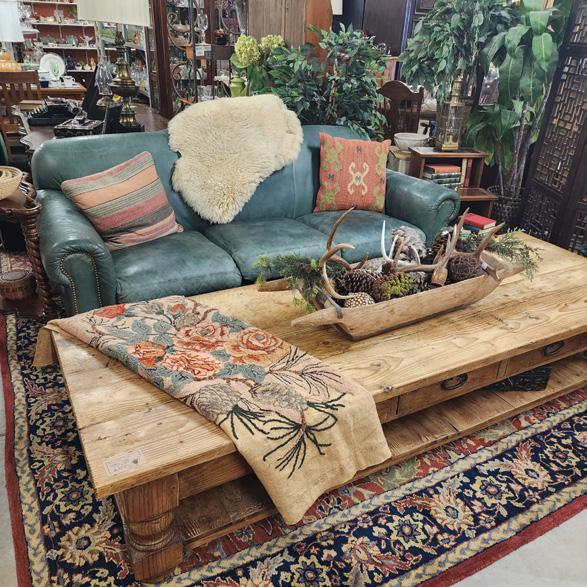
Celebrating 32 Fabulous Years!

Over 6,000 Square Feet of recycled treasures mixing old with new! DECOR & FINE COLLECTIBLES



16. F v CC e xe C utive C H e F a ndy Blanton
20. w at CH party pairing S
23. aS k t H e But CH er
25. Mu SH roo M Soup wit H l ong r i C e
26. g ruyere Mu SH roo M t oa S t
28. a dapting to Cli M ate C H ange in n ort H we S tern Montana
42. Fall d e S ign wit H w rig H t’ S Furniture
Flat H ead C H errie S d ebbie Burke
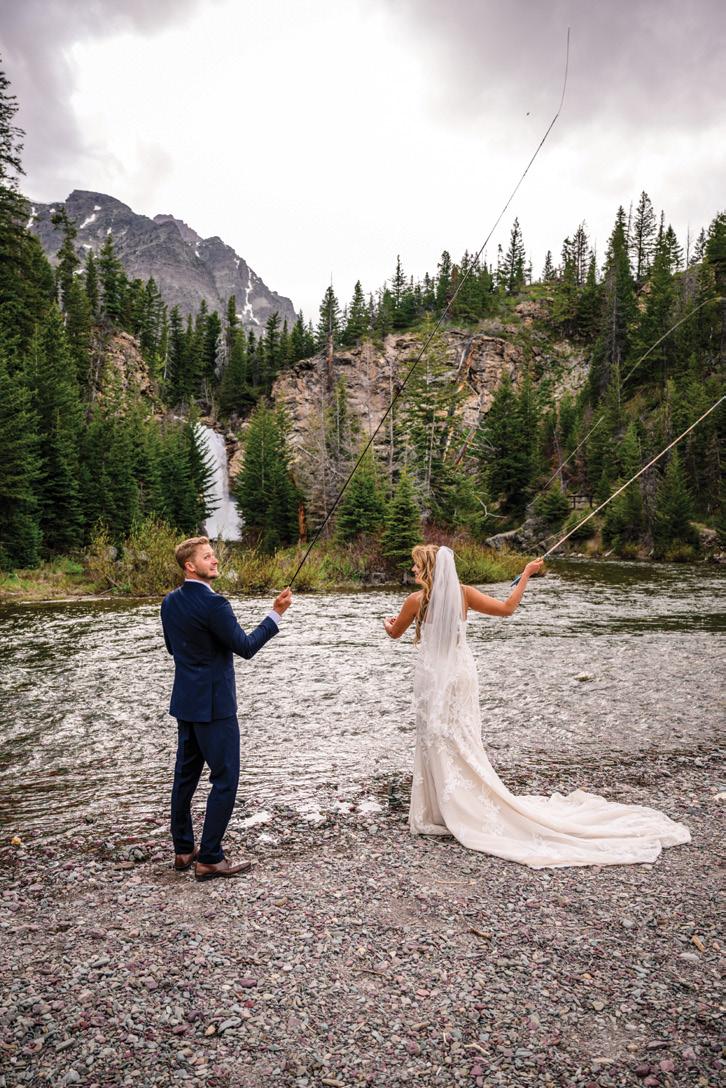

Jessa ash
Jessa started her career in the health sector but she felt something was missing and switched gears. Now as a financial planner, she has found the niche that allows her to help people achieve their financial goals. Read Mary Wallace’s story about Jessa on page 14 in the Business & Health side.





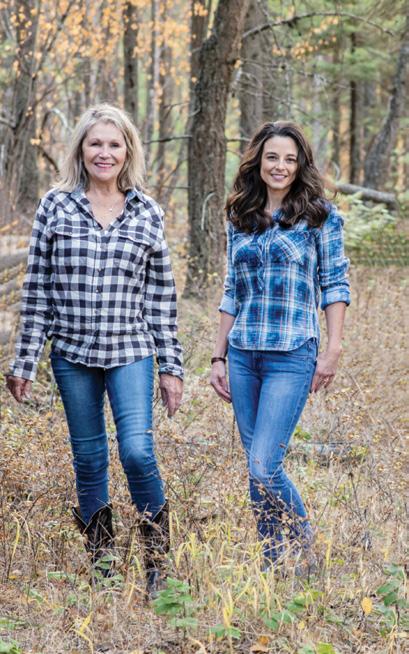
As the warm hues of summer begin to fade and the crisp air of autumn whispers its arrival, we're filled with a sense of gratitude and excitement. We hope this issue of 406 Woman Magazine finds you well and ready to embrace all that fall brings.
This season, as always, is a time of change and transformation. It's a time to reflect on the past, savor the present, and look forward to the future. We've curated this issue with the intention of inspiring you as you embark on this new chapter.
Whether it's a cozy recipe to warm your soul, a stylish outfit to refresh your wardrobe, or a thought-provoking story to ignite your imagination, we hope you'll find something within these pages that speaks to you.
Thank you for being a part of the 406 Woman community. Your support means the world to us. We wish you a fall season filled with joy, inspiration, and all the simple pleasures that make life so beautiful.


Warmly,





publisher Cindy gerrity cindy@montanasky.net
business manager daley Mcdaniel daley@montanasky.net


view current and past issues of 406 woman at woman
managing editor kristen Hamilton montanakristen@gmail.com www.406 w oman.com
creative & social media director amanda wilson afwphotography@me.com
design
Sara Joy pinnell sara@mrsandmrpublishing.com
photographers
daley Mcdaniel photography
amanda wilson photography aCe photography
Published by Skirts Publishing six times a year
704 C East 13th St. #138 Whitefish, MT 59937 info@406woman.com
Copyright©2024 Skirts Publishing
Want to know about great events, open houses, and more? Like us on Facebook at facebook.com/406 Woman
406 Woman is distributed in Bigfork, Columbia Falls, Kalispell, Missoula, Whitefish and every point in between. Check out www.406woman.com for our full distribution list.
Have a great story idea or know someone that we should feature? Email us with your comments & suggestions.
Interested in increasing your business and partnering with 406 Woman? Check out www.406woman.com.
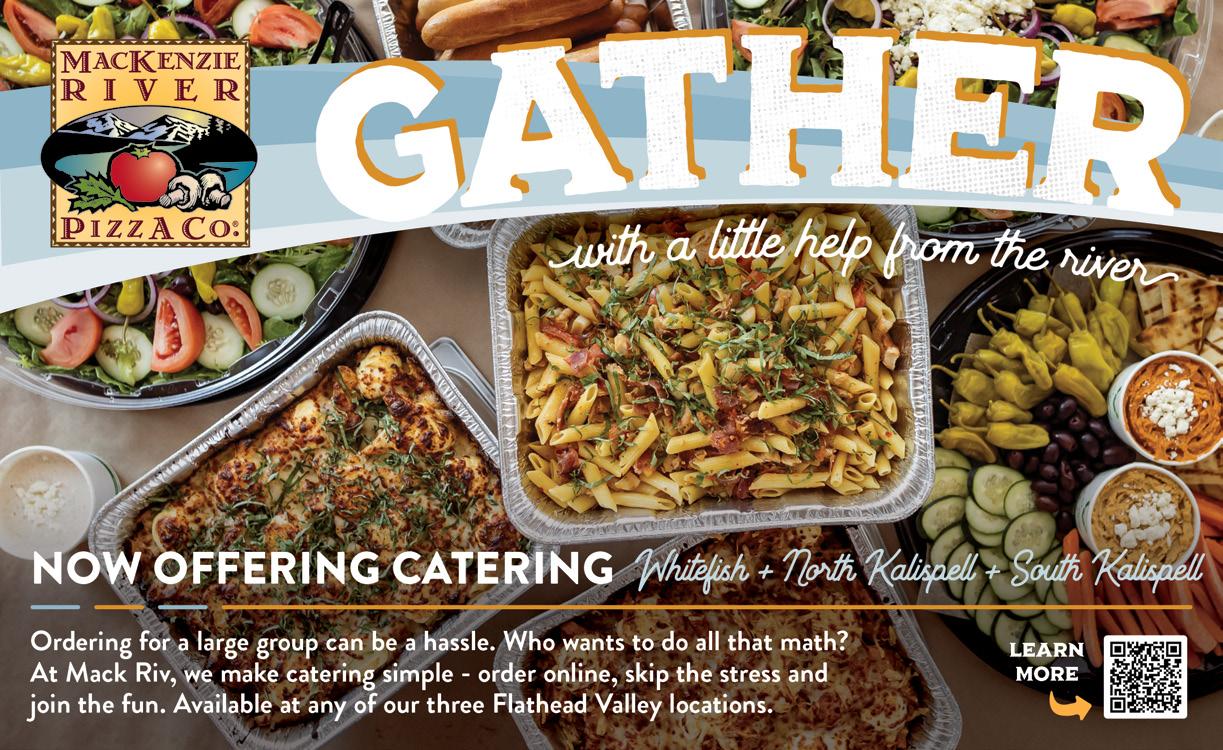

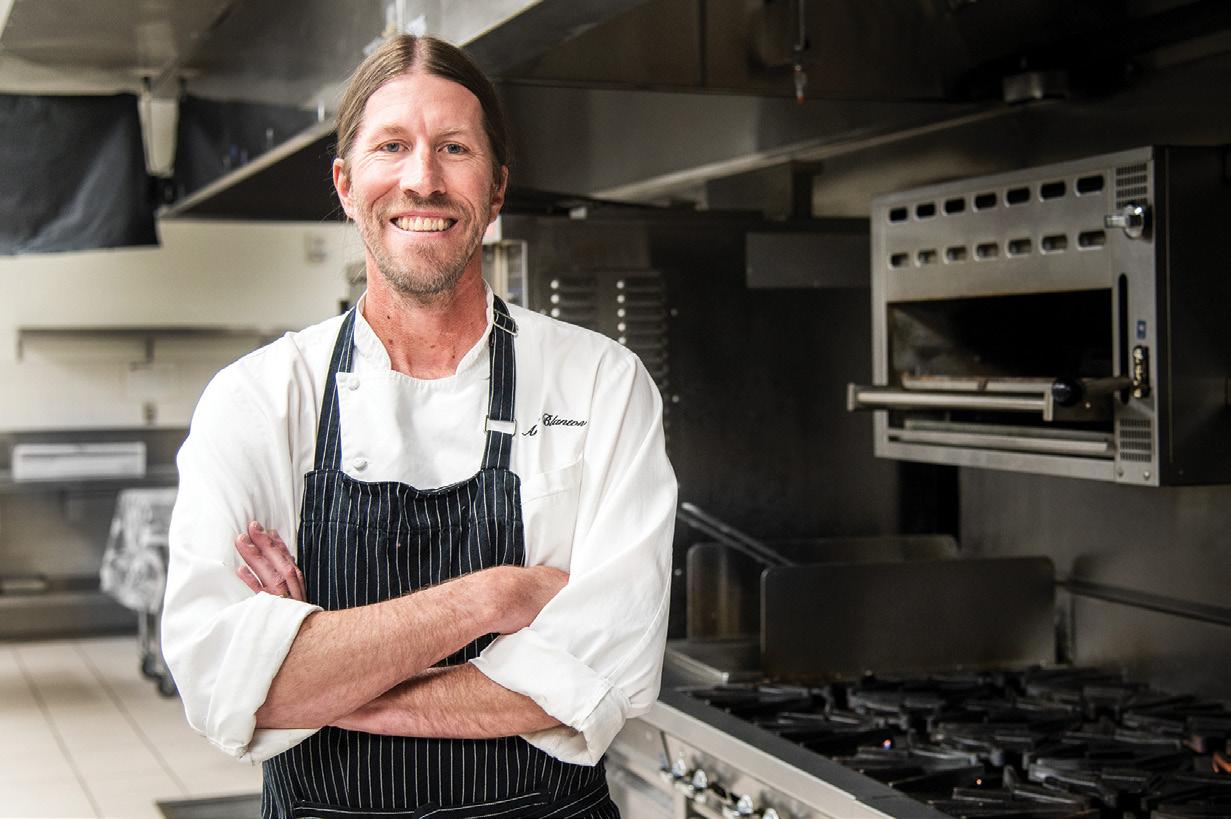
Written by Julie Brempelis, Assistant Director, Marketing & Communications
Flathead Valley Community College’s Culinary Institute of Montana is thrilled to announce the appointment of Chef Andy Blanton as the program’s new Executive Chef. Blanton brings a wealth of experience, innovation and passion to the program, which will strengthen the learning experience for FVCC’s culinary students.
“Chef Blanton and I have worked together on events over the years and I’ve appreciated his attention to detail and commitment to excellence; the hallmarks of our program at FVCC’s Culinary Institute of Montana. We’re excited to partner in this new chapter and continue the development of culinary programming suited to the challenges of the industry and our local workforce,” says Culinary Program Director Chef Manda Hudak.
Blanton leads FVCC’s culinary program after the retirement of chef Howard Karp, who joined the
college in 2008 as an adjunct professor. Karp took on the executive chef role in 2012.
Blanton attended the Culinary Arts Institute of Louisiana in Baton Rouge and later trained at Commanders Palace in New Orleans, the 1996 recipient of the James Beard Award for most outstanding restaurant. He moved to Whitefish in 1999 and was named Executive Chef at Cafe Kandahar a year later. In 2006, he purchased the restaurant with his parents.
Blanton, five-time James Beard Award “Best Chef” semifinalist, joins FVCC after gaining over two decades of local and national acclaim at Café Kandahar. Under Blanton’s leadership, the restaurant received numerous accolades and became a staple of farm-to-table, creative cuisine. His philosophy centered around utilizing local, seasonal ingredients to create innovative dishes that celebrate the flavors of Montana. He stepped away from the restaurant business in June 2023.
“We are very pleased to welcome James Beard-recognized Chef Andy Blanton to our Culinary Institute of Montana,” said FVCC President Jane Karas. “His exceptional knowledge and skills and comprehensive experiences will benefit our students and the continued growth of our culinary program. We look forward to Andy sharing his expertise with our students and the FVCC community.”
As the new Executive Chef, Blanton is excited to share his expertise and passion for the culinary arts with the next generation of chefs. “I’m looking forward to a new chapter in my career and being able to share my knowledge, teaching the future of culinary through education. I look forward to raising awareness for this great program offered right here in the Flathead Valley.”
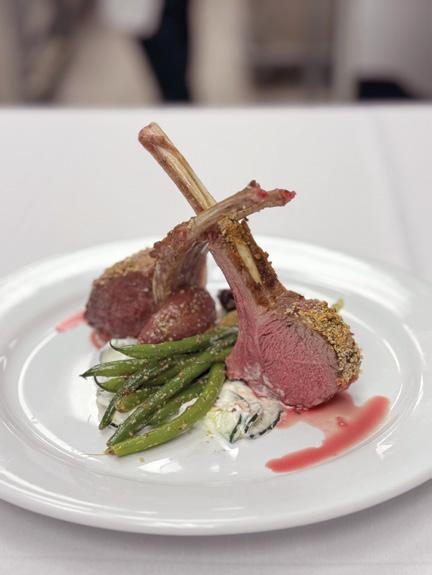
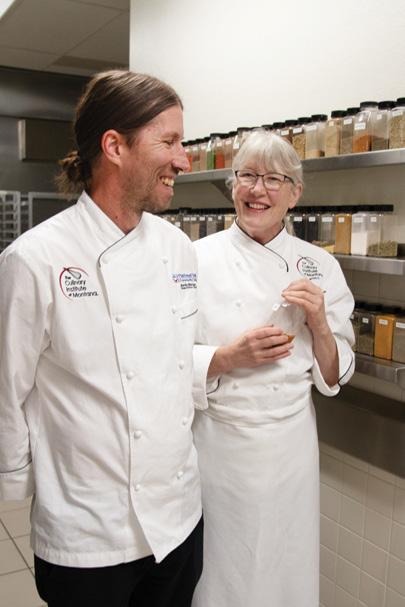
The public will get the first taste of Blanton’s creations at the FVCC Foundation’s Festival of Flavors fall events, kicking off September 13 and culminating in the 17th Annual Grand Wine Tasting at Wachholz College Center. Hudak, whose experience includes prestigious stints such as the Director of Food and Beverage at the Ocean Reef Club, is excited for Blanton to lead students throughout FVCC’s 17th Annual Festival of Flavors. This year’s theme is “The Crush”- that moment when the grape harvest comes to a close and the juices are extracted, bringing the community together in support of the harvest. There are a variety of ways for you to experience "The Crush'' and all proceeds go to support student scholarships at FVCC.
Friday, September 13 at 6pm | Festival of Flavors Homecoming
Located at the I.A. O'Shaughnessy Outdoor Amphitheater at the Wachholz College Center for an all-ages event that evokes the spirit of a quintessential fall tradition. 406 BBQ is serving up an inspired menu you can enjoy while listening to local
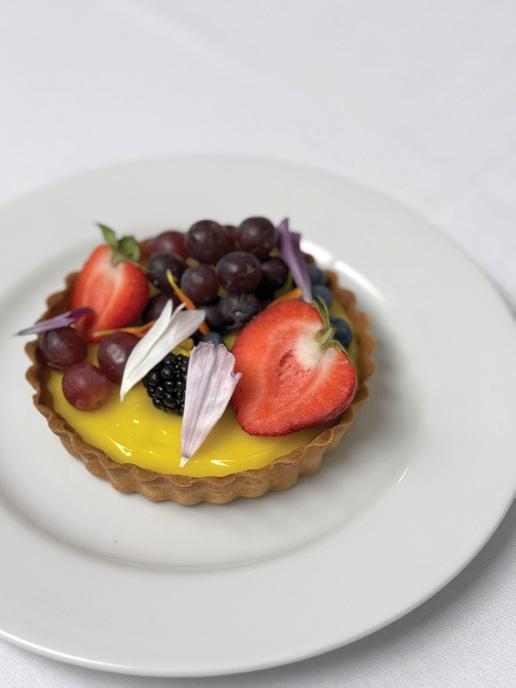
As the new Executive Chef, Blanton is excited to share his expertise and passion for the culinary arts with the next generation of chefs.
favorites Archertown in a beautiful outdoor setting. There will be plenty of games for the kids and raffles for the adults to keep the fun going as the sun goes down.
Saturday, September 28 at 6pm | Grand Wine Tasting and Live Auction
The stunning Wachholz College Center is the backdrop for the best food and wine party of the year! Over a dozen local chefs and restaurants will be offering up their best “Crush” dishes and an equally impressive list of wines provided by Summit Beverage. The Grand Wine Tasting is also the place where you can bid on some truly unique live auction packages, with all proceeds benefiting student scholarships.
Friday, September 13-Saturday, September 28 | Online Auction
Throughout the Festival of Flavors, our online auction offers everyone the chance to bid on dozens of exclusive packages, including wine and culinary delights, along with local goods and experiences. Festival of Flavors enters its 17th season and is the college’s largest fundraiser for scholarships each year. Last year, the Foundation was able to raise over $400,000 for student scholarships through its Festival of Flavors events thanks to our generous donors and sponsors.
Visit fvcc.edu/about/fvcc-foundation/17thannual-festival-of-flavors for more information on all of the Festival of Flavors events.
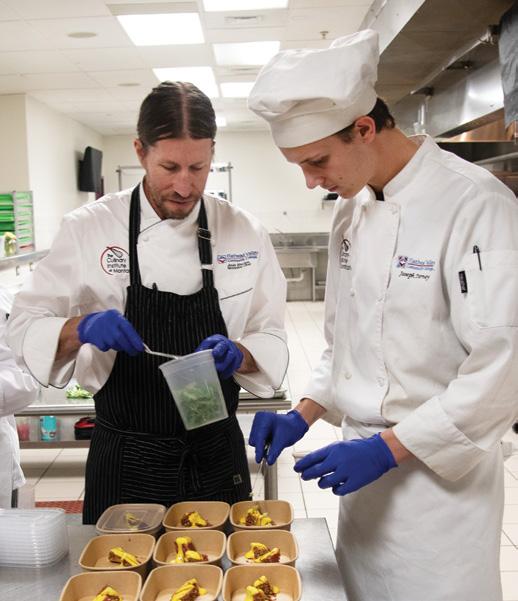

FVCC’s Culinary Institute of Montana provides students with a wide variety of skills in the culinary arts industry. Students take five semesters of instruction in cooking and baking, as well as additional training involving table services, menus, cost controls, storeroom and stewarding to earn an Associate of Applied Science degree in Culinary Arts and Catering. Throughout their time at FVCC, students gain invaluable experience putting what they’re learning in the classroom to work for the community through Chef’s Tables, Modernist Dinners, and FVCC Foundation’s Festival of Flavors annual events and private dinners.
For more information about FVCC’s Culinary Institute of Montana, visit fvcc.edu/culinary.



By Mary Wallace
It’s football season, and time for all the parties! All the tailgate parties! All the watch parties! All the not-reallyfootball-fans-but-in-it-for-the-food parties! Chances are that you will either be attending or hosting one.
Once the food menu is finalized for game day, it's time to decide what drinks will be served. The folks at the Liquor Barn have once again shared some spirited drinks and pairings to help complete a fabulous game day menu.
SET THE MOOD FOR GAME DAY WITH A TEQUILA-BASED COCKTAIL
When serving grilled meats like chicken or steak, a Paloma pairs well. The rich flavors of these dishes are complemented by the zesty notes in the tequila-based cocktail. Don't forget about dessert! A Paloma also pairs nicely with fruity desserts like sorbet or fresh berries.

To make this refreshing-tasting, sweet and sour cocktail combine 1.5 oz Don Julio Blanco tequila, 1 oz grapefruit juice, 0.75 oz fresh lime juice, 0.75 oz simple sugar syrup in a cocktail shaker with ice. Shake and strain into a highball glass with ice and top with a splash of club soda. Garnish with a lime or grapefruit wedge.
Nothing complements the refreshing fizz of a tra ditional Mojito like the warm, crispy goodness of Latin-American inspired empanadas. The zing of the Mojito, paired with the savory comfort of the empanada truly captures the essence of Latino cuisine.
Muddle 0.75 oz lime juice, 0.75 oz simple sugar syrup, and 10 mint leaves in a highball glass. Add 2 oz Captain Morgan White Rum, crushed ice and swirl. Top with 2 oz soda water and garnish with mint leaves and a lime wedge.
Or try a watermelon infused mojito cocktail with grilled garlic shrimp tacos. Or pineapple infused mojito with grilled bbq chicken pizza. Or manda rin infused mojito with nachos. You are only lim ited to your own creativity.

Seafood pairs well with the herbal and floral notes of a gin & tonic. A few complementary menus are crab, shrimp, smoked salmon, sashimi, and sushi. A great gin & tonic also pairs well with a meat & cheese board as the tang and saltiness of cheeses balance the botanical and acidic elements of the cocktail. Nuts & berries are also a great match as they balance the sharpness of juniper and floral citrus.
Pour 1.5 oz Tanqueray No Ten Gin into a goblet filled with ice and top with tonic water. Express a grapefruit twist over the glass and stir well. Garnish with a slice of grapefruit and a sprig of thyme.
A Bloody Mary arguably makes its own food pairing and it’s nearly always on the menu at tailgate parties. But we could always add bacon, right? Here’s how to make it:
Fill a mixing glass with ice and pour in 1.5 oz Absolut vodka. Add 5 oz of tomato juice, 4 dashes hot sauce, ⅓ oz of Worcestershire Sauce, ⅓ oz lemon juice, and 1 pinch ground black pepper. Roll to blend & chill, then strain into a highball glass filled with fresh ice. Add a pinch of Garlic Salt on top and garnish with a Lemon Wedge and a Celery Stick. Add a stick of crispy bacon, if desired.
Once the food menu is finalized for game day, it's time to decide what drinks will be served.
The folks at the Liquor Barn have once again shared some spirited drinks and pairings to help complete a fabulous game day menu.
According to many sommeliers an off-dry Riesling, Gewürztraminer, or an off-dry Chenin Blanc are ideal wines to pair with buffalo wings. Any of these wines are slightly sweet and they all offer a bright citrus acidity that is vigorous enough to stand up to a spicy buffalo butterbased sauce. The hint of sweetness in these wines help to cool off the heat and spiciness.
Jalapeno Poppers? Zinfandel!
The medium-bodied, jamminess of Zinfandel helps to enhance the bacon flavors in the poppers bringing together two of the best tastes: bacon and wine!

Ingredients
12 medium fresh jalapeño chili peppers, halved lengthwise and seeds removed
1 (8 ounce) package cream cheese, softened
1/3 cup bacon jam
1 cup finely shredded mild cheddar cheese
2 green onions, thinly sliced
Preheat oven to 375°F. In a medium bowl combine cream cheese, cheddar cheese and bacon jam until well combined. Spoon mixture into jalapeño halves; place halves on foil-lined, rimmed baking sheet. Bake 18-20 minutes. Remove and top with onions.
Here’s to an enjoyable fall sports season and to the great gatherings they bring!
“The most valuable player is the one who makes the most players valuable.” — Peyton Manning




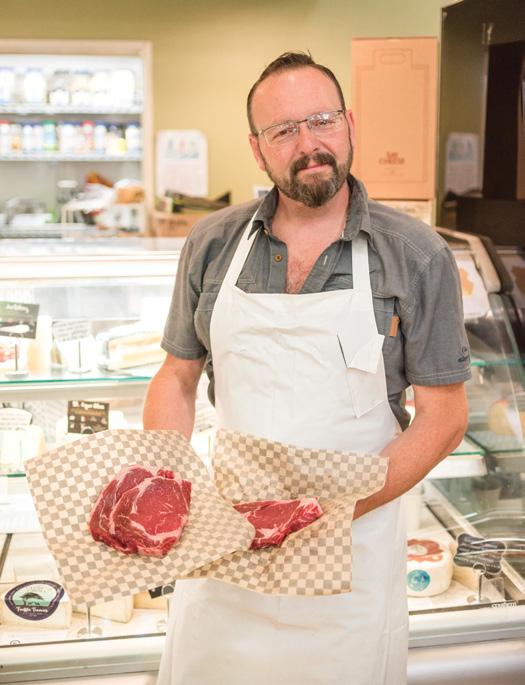

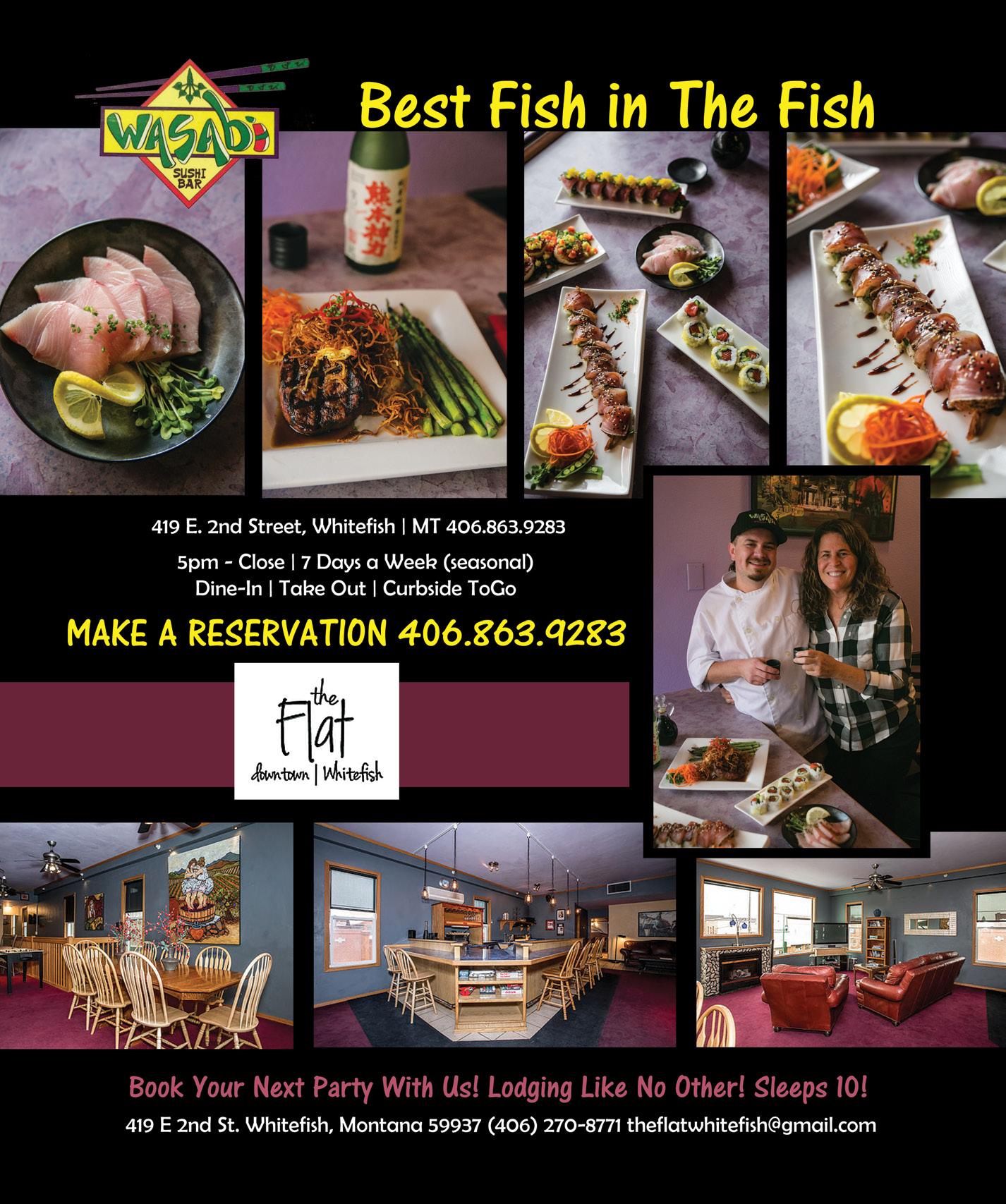
By Justin Pinnell
I made homemade soups for more than a decade for our bistro we owned in the area. Many of the soups were fan favorites, however, this one had a cult following. It is a long rice delight, where the rich, umami flavor of mushrooms takes center stage. After the mushrooms are sautéed to perfection in butter, they blend seamlessly with caramelized onions, a dash of dill weed, and a touch of black and red pepper (for a delightful kick). When sherry is added, it creates a creamy, savory comforting broth. Garnished with fresh parsley and salt to taste, this dish not only satisfies your taste buds but also gives you the nutritional benefit of mushrooms. Packed with antioxidants and essential nutrients, mushrooms help support your immune system. So, share a bowl with your family and friends, because this recipe is as nourishing as it is delicious! Enjoy!
Ingredients
1 medium onion (thinly sliced)
5 oz. fresh white mushrooms (sliced)
3 T. butter
Directions

1/2 c. flour
4 c. chicken stock
1½ c. cooked long rice
1 c. half-and-half
1/4 c. sherry fresh parsley
Cut sliced onion into quarters. Cook onion and mushrooms in butter, until onion is transparent. Add flour and stir vigorously to prevent clumps. Add chicken stock, while stirring, cook for 15 minutes.or until broth thickens on medium heat. Add cooked long rice, cream, and sherry. Heat thoroughly for about another 15 minutes. Garnish with parsley.

Ingredients
4 slices sourdough or 6 slices French bread
1 1/2 cups grated Gruyère or Swiss cheese (or a blend of both for enhanced flavor)
1 large onion, thinly sliced
1 pound mushrooms, sliced
2 tablespoons olive oil
1 tablespoon Worcestershire sauce
1/2 cup white wine
1/2 teaspoon salt (or to taste)
1 teaspoon black pepper
2 tablespoons butter
1 teaspoon chopped fresh thyme (for garnish)
Directions
SauTé The muShroomS aNd oNioNS: Heat olive oil in a large pan over medium heat. Add the sliced onions and mushrooms, stirring to coat them in the oil. Sauté for about 5 minutes until they begin to soften. Pour in the white wine and Worcestershire sauce, continuing to cook and stir for an additional 15-20 minutes, or until the wine is mostly evaporated and the onions and mushrooms are caramelized and sticky. Season with salt and black pepper.
PrePare The ToaST: Preheat your broiler. Spread butter evenly over the slices of bread and place them in a single layer on a large sheet pan. Broil until the top side is lightly browned, about 1-3 minutes. Flip the bread slices over and toast the second side until browned, about another 1-3 minutes. Remove the bread from the oven and let it cool slightly, until just warm to the touch.
aSSemBle The ToaST: Evenly distribute the grated cheese over the top of each slice of toasted bread. Spoon the mushroom and onion mixture on top of the cheese.
Broil The ToaST: Return the sheet pan to the oven under the broiler. Watch carefully and broil until the cheese is melted and bubbling, and starts to turn golden brown, about 2 minutes.
GarNiSh aNd Serve: Remove from the oven and sprinkle with chopped fresh thyme. Serve immediately for a deliciously savory treat.
Enjoy your Gruyère Mushroom Toast with its rich, caramelized flavors and melty cheese topping!

By

As horticulturists, we’ve spent years nurturing plants, learning from the land, and sharing our passion for education with others. But recently, our work has taken on a new urgency. The signs of climate change are all around us– in the unpredictable cold spells, the shifting growing seasons, and the weather patterns that seem less and less familiar. We have seen these changes firsthand in our production and nursery departments, and in the gardens of those we advise. Since the beginning of the growing season, these changes have prompted us to rethink how we approach gardening in northwestern Montana.
The following article reflects our combined experiences. We want to share how we are adapting our fall gardening practices to meet the challenges of the changing climate, offering practical advice rooted in both personal experience and professional knowledge.
We are learning in real-time how weather can change and present new issues we weren’t expecting in our gardening. From aphid infestations to prolonged heat waves and cold snaps, this year has required more time and patience in our gardening practices. As we learn what cycles our trees, shrubs, and plants go
break dormancy early in spring warm up and then are zapped by the late cold snaps. Trees and shrubs were affected by the cold winter leading to less budding and overall foliage production. The loss of trees and shrubs across communities and landscapes is a reminder of the importance of preventative care for our
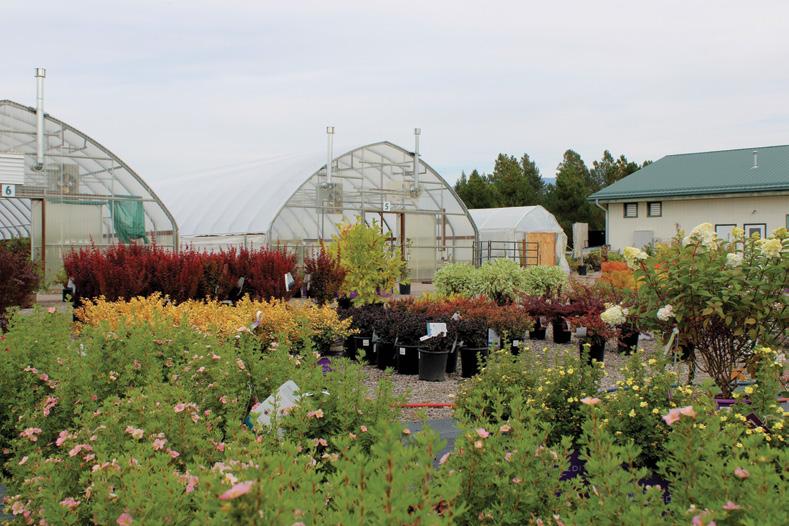
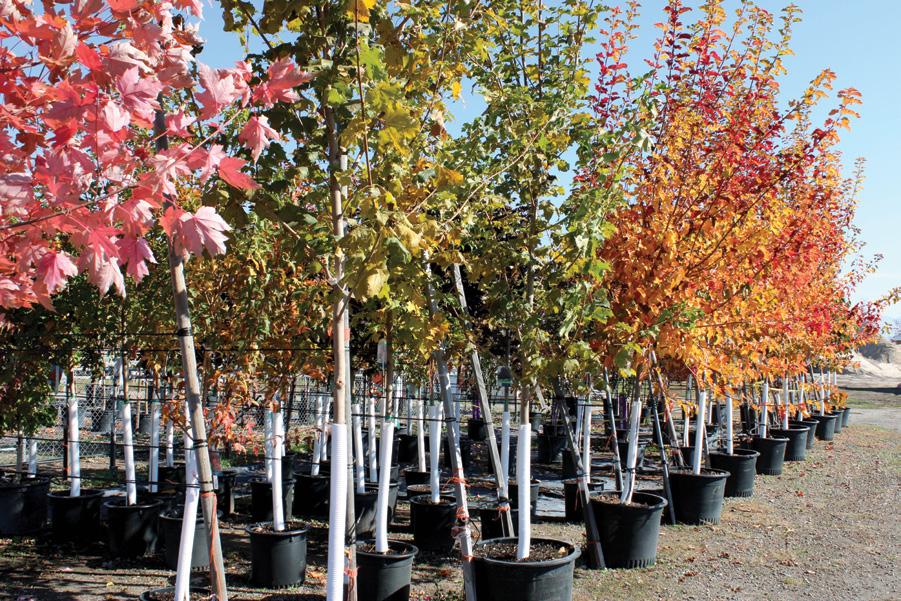
Start a gardening journal. Record temperatures, watering schedule, fertilizer feeding scheduling, rainfall, sun, and shade patterns in your landscape. Starting a journal can help you become a master of your landscape and be a complete gardener.
So, for fall season, it’s crucial to take measures that will help upstand the unpredictable weather patterns.
Start a gardening journal. Record temperatures, watering schedule, fertilizer feeding scheduling, rainfall, sun, and shade patterns in your landscape. Starting a journal can help you become a master of your landscape and be a complete gardener. We suggest you also take note of your landscape and identify areas that suffered from the past winter. Learn from what choice of plant was placed there. If you lost plants in this last cycle, study why and make better choices of plants or trees.
Start planning to add a tree to provide summer shade. Notice anything that didn’t survive transplant, suffered from seasonal storms, or suffered from bad pruning practices. This is a good time to address any compacted soil issues. Adding soil amendments is a great way to provide transplant success and healthy root production. Gather mulch for use after transplanting and when fall pruning is complete, use mulch for moisture and insulation barrier. Look into frost cloth for ornamental conifers, evergreens,
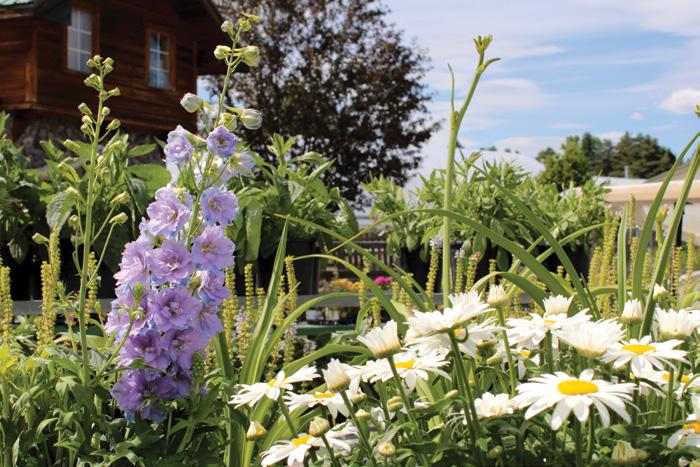

fruit trees, roses, and Japanese maples. Frost cloth helps cut the bitter cold and protect fruit trees that flower early season, helping the flower, pollination, and hopefully fruit setting.
When preparing to harvest early apples, pears, and peaches, keep an eye out for spider mites as they will thrive in this hot dry weather. Powdery mildew will continue in the season with cooler night temperatures coming. Cercospora leaf spot disease on aspens and poplars is common this time of year.
Focus on pruning for proper air circulation, better sunlight penetration, planting powdery mildew-resistant plants, and reducing high nitrogen fertilizers to avoid late-season growth susceptible to mildew.
Make sure you note what equipment you need and get it ahead of time. Choose plant varieties for your zones. (You can view your zone by visiting the United States Department of Agriculture website or visiting our “Availability” tab online). With the growing season extending to the fall, it’s important to read-
just your summer growing routine, such as watering techniques and deadheading.
As a garden center, we have a unique opportunity to support our community in adapting to climate change. We provide resources, such as soil testing kits, organic fertilizers, and climate-resilient plants, to help you make informed decisions.
Climate change presents significant challenges, but by embracing new strategies and adapting our gardening practices, we can continue to cultivate thriving gardens in Northwest Montana. This fall, take the time to remain flexible, observant, and willing to experiment with new techniques. Ask yourself how you can adapt your practices to meet these challenges and keep a closer eye on the landscape you have invested in.
Hooper’s Garden Center 2205 MT Highway 35 E in Kalispell 406-752-2770 - www.hoopersgarden.com
By Debbie Burke

The 2024 cherry season in the Flathead Valley is now only a delicious memory of glossy, red-black fruit whose juice is a sweet explosion in the mouth.
This was a tough year for the iconic cherry orchards on Flathead Lake. In January, temperatures suddenly dropped from the 40s and 50s to minus 16. The cold snap nipped the tiny nubs on branches where blossoms form and fruit later develops. That resulted in an unusually small harvest.
Small but still as tasty as always.
When my husband and I moved to Kalispell in 1988, we were introduced to Flathead sweet cherries. After one bite, we became unapologetic addicts. That summer, a neighbor and I split a lug, intending to can them. Instead, we gobbled most of them fresh, resulting in only a few pint jars to save for winter.
But catastrophe struck in late January 1989. The month had been unseasonably warm. That tricked fruit trees into thinking it was spring and they started to come out of dormancy.
Then overnight, the temperature plummeted more than 50 degrees to minus 20.
The orchards around Flathead Lake were devastated. Thousands of trees perished. Some growers gave up and sold dead trees for firewood. Others replanted with apple trees which are hardier.
Thankfully, many orchard owners kept their faith in sweet cherries and started over.
Although the umbrella term "Flathead cherries" is common, there are actually several varieties grown around the lake. Early trees were "Lambert" cherries. After the big freeze in '89, Lamberts were mostly replaced by "Lapins," a little hardier variety that ripens later. "Rainier" cherries are also popular.
Sweet cherry trees take five years to bear fruit and seven years to full productivity. A mature tree can produce up to 100 pounds of fruit a season.
Local lore says the first cherry orchard on Flathead Lake was planted as an experiment in 1893 by Nova Scotia-born pioneer Margaret Estey. The temperate microclimate around the lake, combined with good, well-drained soil and pure glacier-fed water, convinced Estey
that cherries could survive in the far north. Her experiment was a resounding success.
By the 1920s, cherries became a viable commercial crop. In the 1930s, Flathead cherries were shipped by rail all over the country from the packing plant in Kalispell. The old plant location later became the Kalispell Center Mall. The current packing facility is in Finley Point.
Rain at the wrong time causes fruit to split. Less-than-perfect cherries become juice, a delicious drink rich in B, C, and K vitamins, fiber, potassium, antioxidants and anti-inflammatory compounds. Cherries are good for skin, muscle recovery after exercise, cardiovascular health, blood pressure, arthritis, and sleep.
Fun fact: Montana and part of Japan, famous for its cherry blossoms, are the same latitude, 46-49 degrees N.
Cherries can even inspire a mystery author! The summer before last, on a postcard perfect day, I drove along the east lake shore to stock up on cherries. The delicious errand took an unexpected side trip when I spotted the burned wreckage of a house. Behind the house was a cherry orchard on a slope that ran down to the lake.
Local lore says the first cherry orchard on Flathead Lake was planted as an experiment in 1893 by Nova Scotia-born pioneer Margaret Estey. The temperate microclimate around the lake, combined with good, well-drained soil and pure glacier-fed water, convinced Estey that cherries could survive in the far north. Her experiment was a resounding success.
The roof had partly collapsed, leaving an exposed chimney amid charred timbers and drywall.
The haunting image stuck with me. What was the story behind the burned house?
Around the same time, I'd been in contact with author friend Jeffrey Yamaguchi. Jeff and his family planned a pilgrimage to Rohwer in Arkansas, one of the concentration camps where people of Japanese descent were sent during World War II. Jeff's grandparents had been interned there and his grandfather ran the camp's photography studio. His photos chronicled the daily lives of people who, despite being American citizens, either by birth or naturalization, had been uprooted from their homes and businesses and incarcerated by order of President Franklin Delano Roosevelt.
That triggered the sad recollection that Fort Missoula had also been an internment camp.
One day at lunch in Bigfork with my partner in crime, Leslie Budewitz (who alternates writing this book column), we started brainstorming a mystery about a burned house with a cherry orchard.
Jeff's historical research inspired a fictional character—a man of Japanese descent, born during
World War II inside the fence of an internment camp. He dreamed of his own cherry orchard, to follow the legacy of his ancestors who'd raised cherries in Japan. Racial prejudice denied Japanese-Americans the right to own real property until the 1950s.
A character named Jerome Kobayashi came to life. After the 1989 freeze, he and his wife bought a bankrupt orchard. They replanted new trees with their own hands. Over decades of hard work, they built a thriving business. Mr. K's roots run deep. His wife's ashes are buried on the land. For years, he's turned down all offers to buy his property.
But now someone won't take no for an answer. When Mr. K's house is destroyed by arson, a body burned beyond recognition is found in the basement. Suspicion falls on Mr. K who's hiding secrets that trace back to centuries-old Japanese legend.
His granddaughter asks for help from intrepid investigator Tawny Lindholm and her charismatic lawyer-husband Tillman Rosenbaum.
The truth is tangled in roots deeper and more twisted than the cherry tree.
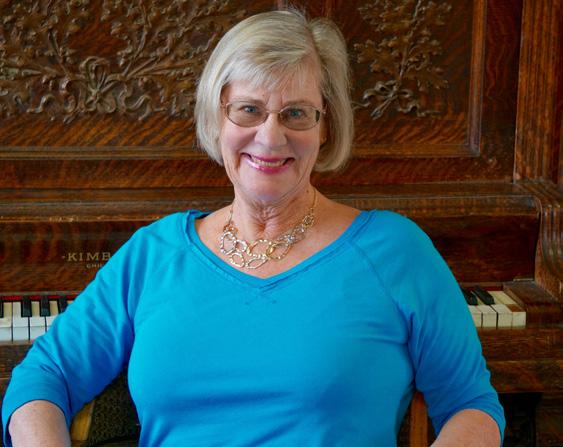
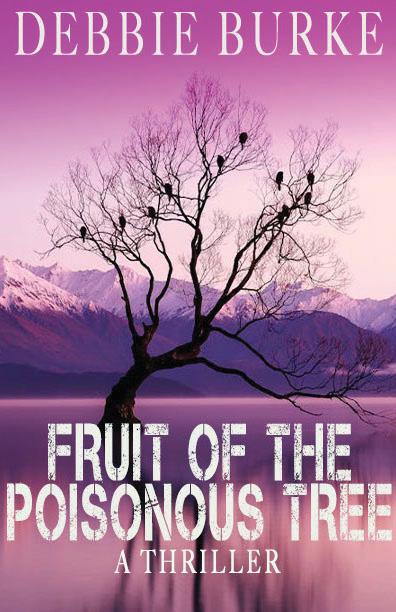
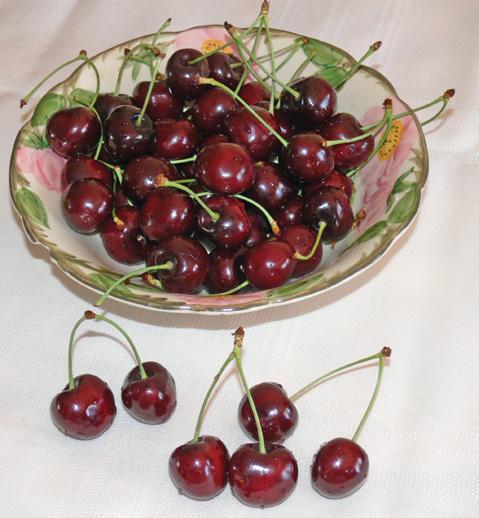
Fruit of the Poisonous Tree is the ninth book in my Tawny Lindholm Thriller series. The title refers to a legal doctrine about evidence that is illegally obtained. Coined by Supreme Court Justice Felix Frankfurter in 1939, the vivid metaphor says if a source of evidence (the tree) is tainted, anything gained from it (the fruit) is also tainted and can't be used in court.
Since the setting for this mystery is a cherry orchard on Flathead Lake, the title seemed just right.
And that's how a trip to buy Flathead cherries took a twisted detour into historical research, fueled by the devious imaginations of two mystery authors over lunch, and led to a new book!
Debbie Burke's award-winning Tawny Lindholm Thriller series is available in Kalispell at The Bookshelf, the Northwest Montana Historical Center (in the old Central School), Barnes & Noble, and in Columbia Falls at Bad Rock Books. Ebooks are for sale at Amazon, Barnes & Noble, Apple Books, and all major online booksellers.
BOOK CLUBS! - Would you like Debbie to talk with your book club? Email debbieburkewriter@gmail.com
For more details, visit debbieburkewriter.com
Email: debbieburkewriter@gmail.com
Website: www.debbieburkewriter.com Twitter: @burke_writer


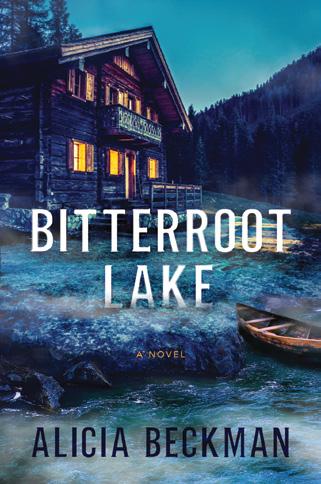
Beckman
Review by Kristen Hamilton
I was intrigued by the title of Alicia Beckman’s mystery novel “Bitterroot Lake” having lived in Northwest Montana for close to 30 years. Personally, I love a story that incorporates geographic familiarity and Beckman did not disappoint.
A tragedy at the family’s lakefront lodge at Bitterroot Lake in Montana 25 years earlier still haunts Sarah. She had a vision that she ignored and a young man was killed. Her answer was to leave the area and build a new life even if that meant sacrificing her friendships with her closest friends.
But after losing her husband to cancer, she returns to Montana and the lodge for healing.
Upon her arrival, she is greeted by an old friend who is a suspect in a murder seemingly tied to the tragedy from their past.
The visions return and she works to discover the meaning of the dreams and the strength to carry on. Along with her friends, they work together to uncover the history of the lodge and the secrets it holds.
I really enjoyed the suspense of the story and waiting for the next secret to be unveiled. I couldn’t wait to get to the conclusion but at the same time didn’t want the story to end. Beckman kept me on the edge of my seat so to speak and I’ll look forward to reading her next novel.
About the author: Alicia Beckman adored living in Seattle as a college student and young lawyer, but is happiest back home in her native Montana, where she lives with her husband, a musician and doctor of natural medicine, and their full-figured gray tuxedo cat. As Leslie Budewitz, she’s the bestselling author of the Seattle Spice Shop and Food Lovers’ Village mysteries. A three-time Agatha Award winner, for Best Short Story (2018), Best First Novel (2013), and Best Nonfiction (2011), she is a past president of Sisters in Crime and a current board member of Mystery Writers of America.
Find Beckman and Budewitz books at major online booksellers or better yet support your favorite local independent bookstore and ask them to order it for you!
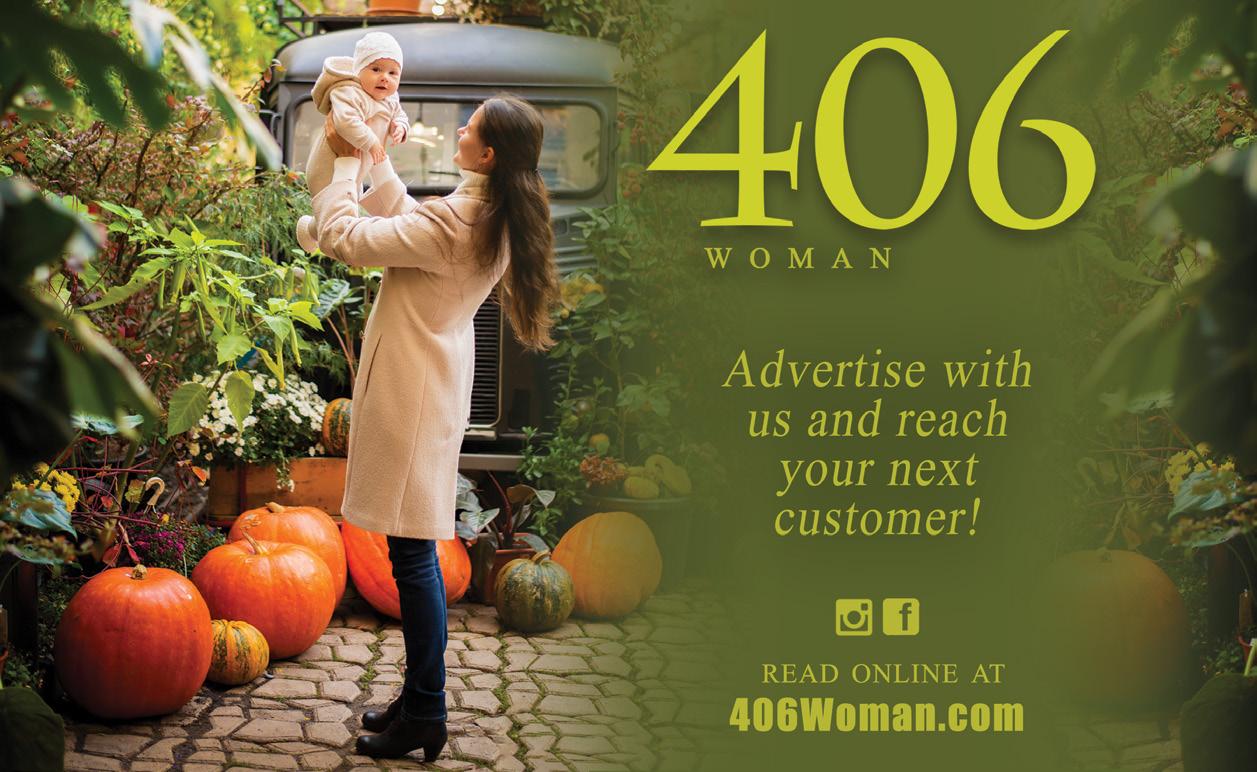





By Paulina Crum - Photos provided by Glacier Symphony & Chorale
As the crisp autumn air settles in, music lovers are in for a treat with an exceptional lineup of concerts that promise to transport audiences on a captivating auditory journey. Our fall season features a diverse array of performances, each celebrating different corners of the world through classical and contemporary compositions. From the intricate melodies of Mediterranean guitar to the evocative symphonies of Scandinavia, this fall’s concert series is set to be an unforgettable experience.

We kick off the season with an evening that promises to be both mesmerizing and enlightening. On our opening night, we are thrilled to welcome Grammy-winning guitarist Jason Vieaux. Renowned for his virtuosity and expressive playing, Vieaux will lead us through a program rich in Mediterranean influences.
The concert will highlight Joaquin Rodrigo’s Concerto de Aranjuez, a masterpiece that has become a cornerstone of the classical guitar repertoire. This evocative concerto, composed in 1939, is celebrated for its lyrical beauty and its depiction of the Spanish spirit. With its vibrant melodies and intricate guitar passages, it beautifully encapsulates the essence of Spanish classical music.
Vieaux will also present John Corigliano’s Troubadours, a contemporary work that brings a fresh perspective to the guitar concerto. Corigliano’s composition reflects the influence of medieval troubadours, blending modern techniques with historical themes to create a dynamic and engaging performance.
The evening will conclude with Ottorino Respighi’s Ancient Airs and Dances Suite, a
collection of pieces inspired by Italian Renaissance and Baroque dance music. Respighi’s orchestration of these ancient tunes brings a lush, evocative sound that completes our Mediterranean journey.
This opening night promises to set an extraordinary tone for the season, immersing the audience in the rich traditions of southern Europe through the delicate and expressive voice of the classical guitar.
Prepare for a night of spellbinding music as the Glacier Symphony presents a program of enchanting compositions. At the heart of this concert is Hector Berlioz’s Symphonie Fantastique, a groundbreaking work that redefined the symphonic form with its vivid storytelling and innovative orchestration. Berlioz’s symphony, known for its dramatic and fantastical elements, will be a highlight of the evening, showcasing the symphony’s journey through the depths of imagination and emotion.
The magic continues with Paul Dukas’ The Sorcerer’s Apprentice , a piece immortalized by its feature in Disney’s Fantasia

With every melody, harmony, and choral arrangement, this performance will be a testament to the transformative power of music, reminding us of the beauty of coming together as a community.
Known for its playful and evocative portrayal of a young apprentice’s mishaps with magic, Dukas’ work adds a whimsical touch to the night.
The concert will also feature Cuban-American cellist Tommy Mesa, who will bring his exceptional talent to the stage performing Camille Saint-Saëns’ Cello Concerto No. 1 in A minor . Mesa’s performance will highlight the concerto’s lyrical beauty and technical challenges, offering a captivating display of his artistry.
This evening of French masterpieces promises a rich blend of innovation and charm, providing a musical experience that is both revolutionary and delightful.
Our fall series also includes a heartwarming concert by the Glacier Chorale, centered around the theme of unity and community. The program is designed to uplift and inspire, reflecting the power of music to bring people together.
The chorale’s performance will emphasize the strength found in unity and the joy of communal expression through song. Each voice in the chorale contributes to a rich tapestry of sound, creating a powerful sense of connection among the performers and the audience. This concert will be a celebration

of the harmony that music can bring to our lives, underscoring the idea that together, we are stronger and more harmonious.
With every melody, harmony, and choral arrangement, this performance will be a testament to the transformative power of music, reminding us of the beauty of coming together as a community.
Our fall season concludes with a celebration of Finnish music, featuring the iconic works of Jean Sibelius. Renowned violinist Rachel Barton Pine will join us to perform Sibelius’s Violin Concerto in D minor, a piece renowned for its technical demands and lyrical beauty. Pine’s performance will bring a fresh and dynamic interpretation to this challenging concerto.
The concert will open with Sibelius’s Finlandia!, a powerful and patriotic work that played a crucial role in the composer’s rise to fame. This evocative piece captures the spirit of Finland and its struggle for independence, resonating with its dramatic and stirring themes.
The evening will also include Sibelius’s Symphony No. 5, a composition inspired by Finland’s natural beauty, including the majestic flight of swans. This symphony’s sweeping
melodies and grandiose structure reflect the composer’s deep connection to his homeland. The final concert of the season will transport audiences to the heart of Scandinavia, offering a profound and beautiful exploration of Sibelius’s musical genius.
As autumn unfolds, our concert series promises to offer a rich tapestry of musical experiences, celebrating diverse cultures and musical traditions from around the world. Each performance is a unique journey, inviting audiences to explore the beauty and depth of classical music in its many forms. Join us for these unforgettable evenings of music that will resonate long after the final note has been played.
Visit glaciersymphony.org for information and tickets.
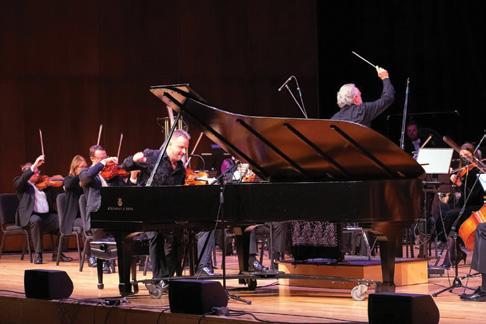






By Mary Wallace & Wright’s Furniture
Sure, leaves turn color, a crisp autumn wind blows, night comes earlier and feels a little cooler. But as Fall unfolds, many find themselves migrating back indoors and embracing all things autumn. Some even feel compelled to initiate a home reset. Some might decide to rearrange their furniture and add cozy Fall touches. Some might be inspired to replace older furniture pieces to refresh their living space. Are you finding yourself itching to change things up around the homestead?
AS WE TRANSITION FROM THE CAREFREE DAYS OF SUMMER TO THE ROUTINES AND RITUALS OF FALL, COME ALONG WITH US TO EXPLORE CURRENT HOME DESIGN AND FURNITURE TRENDS.
Fall trends for the living room this year are plush oversized sofas that have overfilled cushions with spaces to settle in. Look for inviting fabrics, large-scale seating, and functional designs that

A new supplier to Wright’s Furniture is Four Hands, out of Austin, Texas. They check all of these boxes and their goal is to bring thoughtful quality pieces that feel as if they were made expressly for each home, and that will stand the test of time. All of their pieces are developed in-house with globally sourced natural or recycled materials from the world’s best mills and top artisans. Four Hands employs innovative design techniques to create pieces that are inviting, comfortable, and authentically YOU.
Rearrange the furniture. Change the focal point of the room or rearrange the furniture and add a few cozy fall touches and/ or a new signature piece.
Change the lighting. Basic room lighting can be enhanced with a floor lamp or side table lamp that not only illuminates the room but makes a statement all on its own. Add accent lighting to draw attention to art pieces.


Add some accent pieces. A beautiful oversize bowl of wood or stone expresses a sense of style and can also hold a plant or serve as a catchall. Bring in a family heirloom to personalize the look. A lumbar pillow can add comfort as well as a textile interest. Woolen throws and accent pillows add a cozy fall touch.
Oversize textural art pieces are also trending this year, and Wright’s, as always, carries items with a western flair as well as large-scale paintings and prints that will add a welcome pop of color.

Wright Furniture can help coordinate the beauty and comfort of your living spaces by helping craft beautiful designs for a variety of budgets, lifestyles, and preferences.
Wright’s Furniture is open 7 days a week,



We purposely made sure to not visit the east side of Glacier so on our wedding day it was a complete surprise to us. It was unbelievably beautiful, and we felt so blessed to have all four seasons of weather in one day.
Tell us about yourselves…
We are from Northern Nevada and currently live in a small town called Minden just below Lake Tahoe. Our hobbies are a big part of our life. We love to fly fish and spend many weekends on rivers or lakes. In the fall we switch gears and enjoy big game hunting and stockpile our freezer for food. We also both enjoy archery and attend local shoots throughout the summer. The week before our wedding we drove to Montana and spent time visiting other national parks and fishing various rivers along our drive.
Tanner is a Marine vet. After his service, he worked in private security but decided to switch up his career. He is now attending college and pursuing a degree in wildlife management.
Coralee works as forester for a non-profit. Her work includes improving forest health and helping to reduce wildfires.
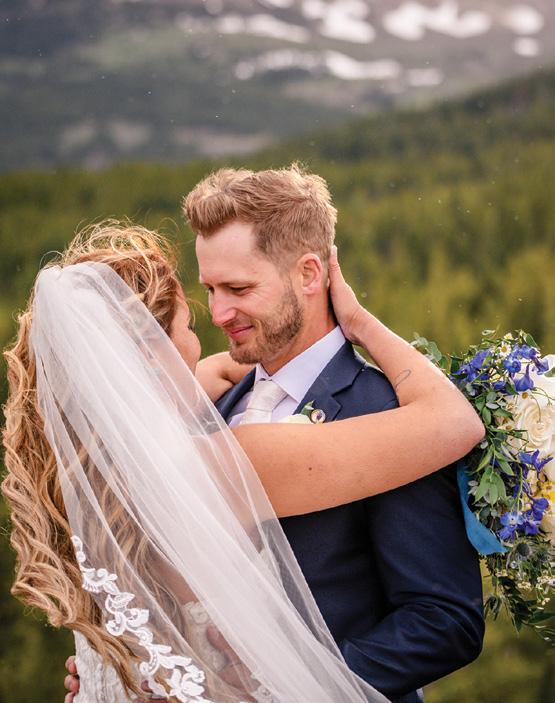

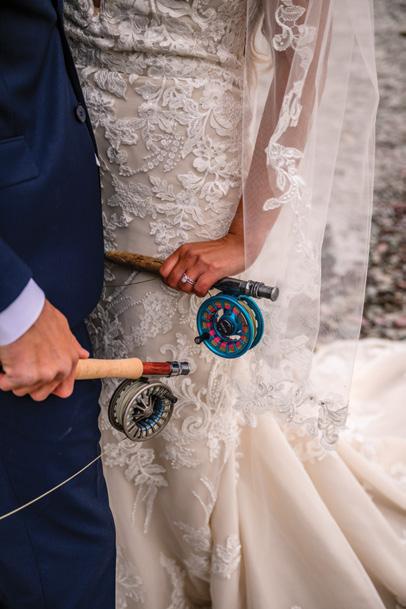
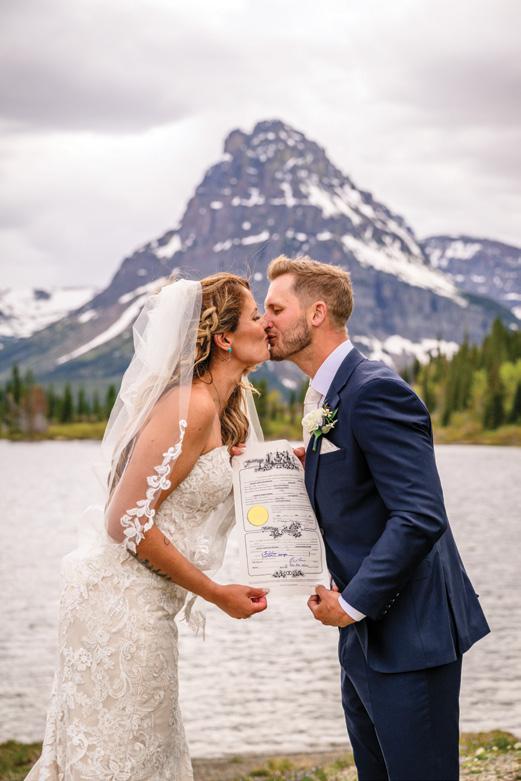


Coralee – What is the trait that you most admire in Tanner?
Tanner is kindhearted and cares about the people around him. I love how he is always eager to help his family and friends. Tanner has an uplifting personality and can bring a smile to the people around him.
Tanner – When did you realize you wanted to get married to Coralee?
I realized I wanted to marry Coralee after our first date. We decided to go fishing at Pyramid Lake Nevada which is known for its big trout. It was a fun and adventurous date. Not only did it snow on us, she also caught more fish than me! After our date I remember telling my cousin “if this girl likes me enough and decides to stick around, I’m gonna marry her.” Lucky for me she stuck around!
Why did you choose the venue you did to get married?
We have a strong passion for the outdoors. In our free time we try to escape to the mountains as much as possible. Glacier National Park seemed to fit our adventurous desires of a beautiful place to get married.
Coralee – What did you enjoy most during your wedding day?
Our wedding was near perfect with only a small group of close family in attendance. An elopement/micro wedding allowed us to focus on each other and the vows we were about to say before God. For a unity ceremony we all stood in a circle and passed our wedding rings around and each family member said a prayer or blessing with the rings during the ceremony.
We purposely made sure to not visit the east side of Glacier so on our wedding day it was a complete surprise to us. It was unbelievably beautiful, and we felt so blessed to have all four seasons of weather in one day.
Tanner – What is your favorite activity to do as a couple?
We live for the outdoors and everything it has to offer. We love to fly fish and on any road trip we bring our fishing gear in case there is good water, and we want to stop and fish. We also enjoy hunting for our food. We like to hunt anything from wild turkeys to elk.
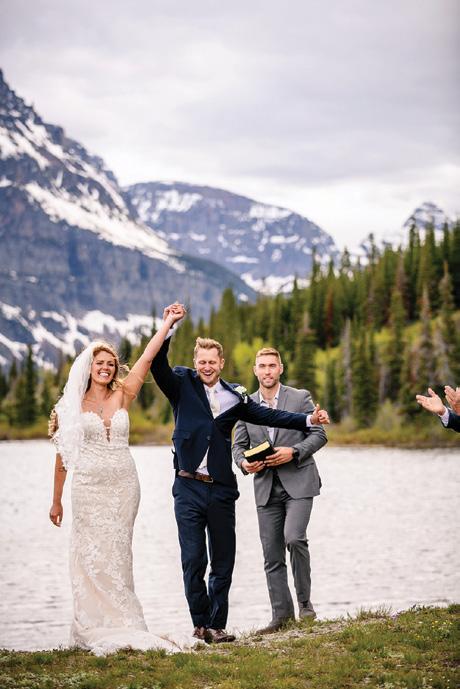
Venue east glacier, pray lake
Photography
Stella with Carrie ann photography
Flowers
Mums Flowers, Montana Saphire
Cake/Dessert
Cake by ephemera
Music
Bride’s Brother played guitar
Dress aegir by pronovias
wear
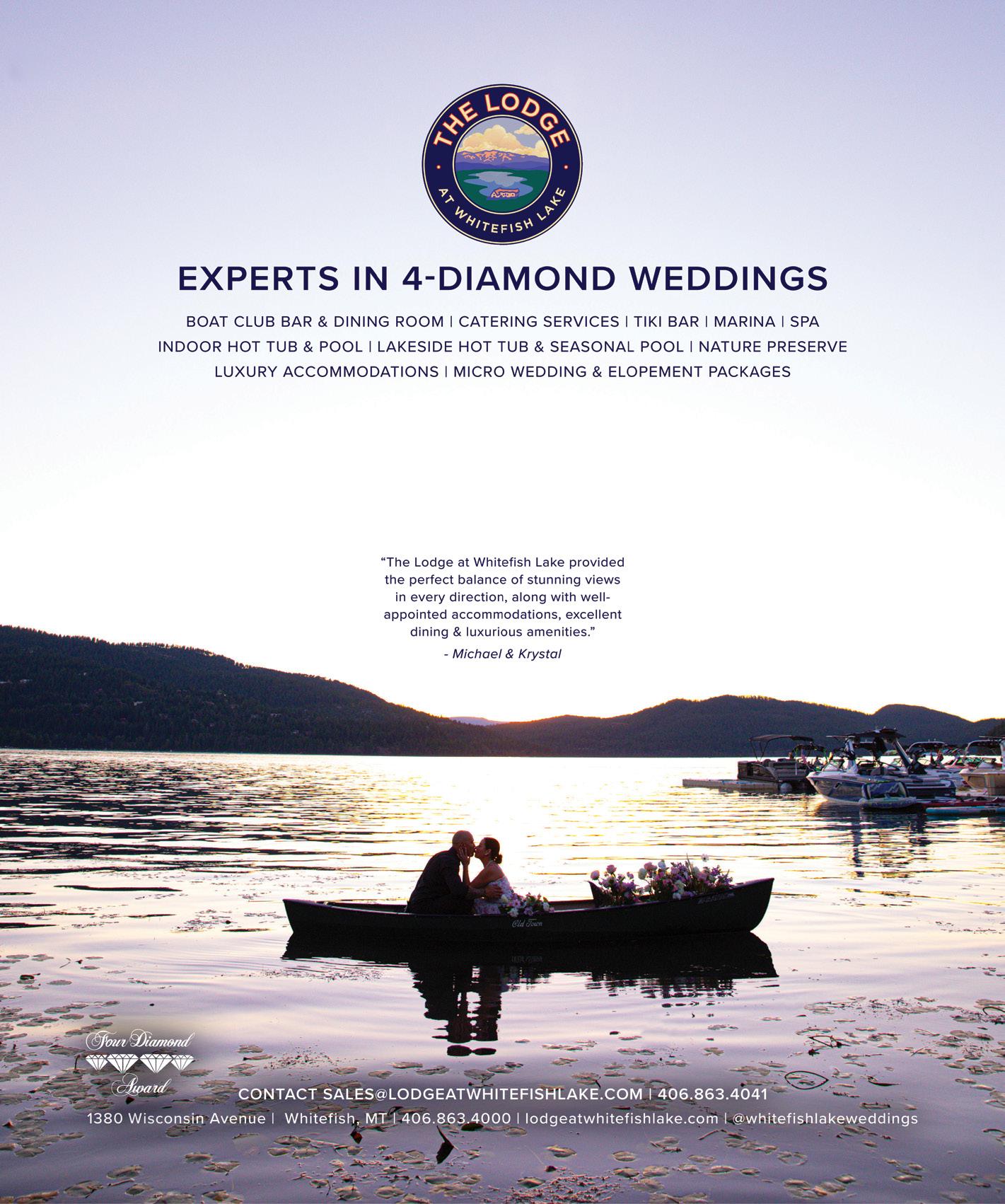




FINE ART ~ BRONZE SCULPTURE ~ JEWELRY ~ MONTANA SAPPHIRES
10 AM TO 6 PM MONDAY THROUGH S ATURDAY - S UNDAYS 1 1 AM TO 5 PM


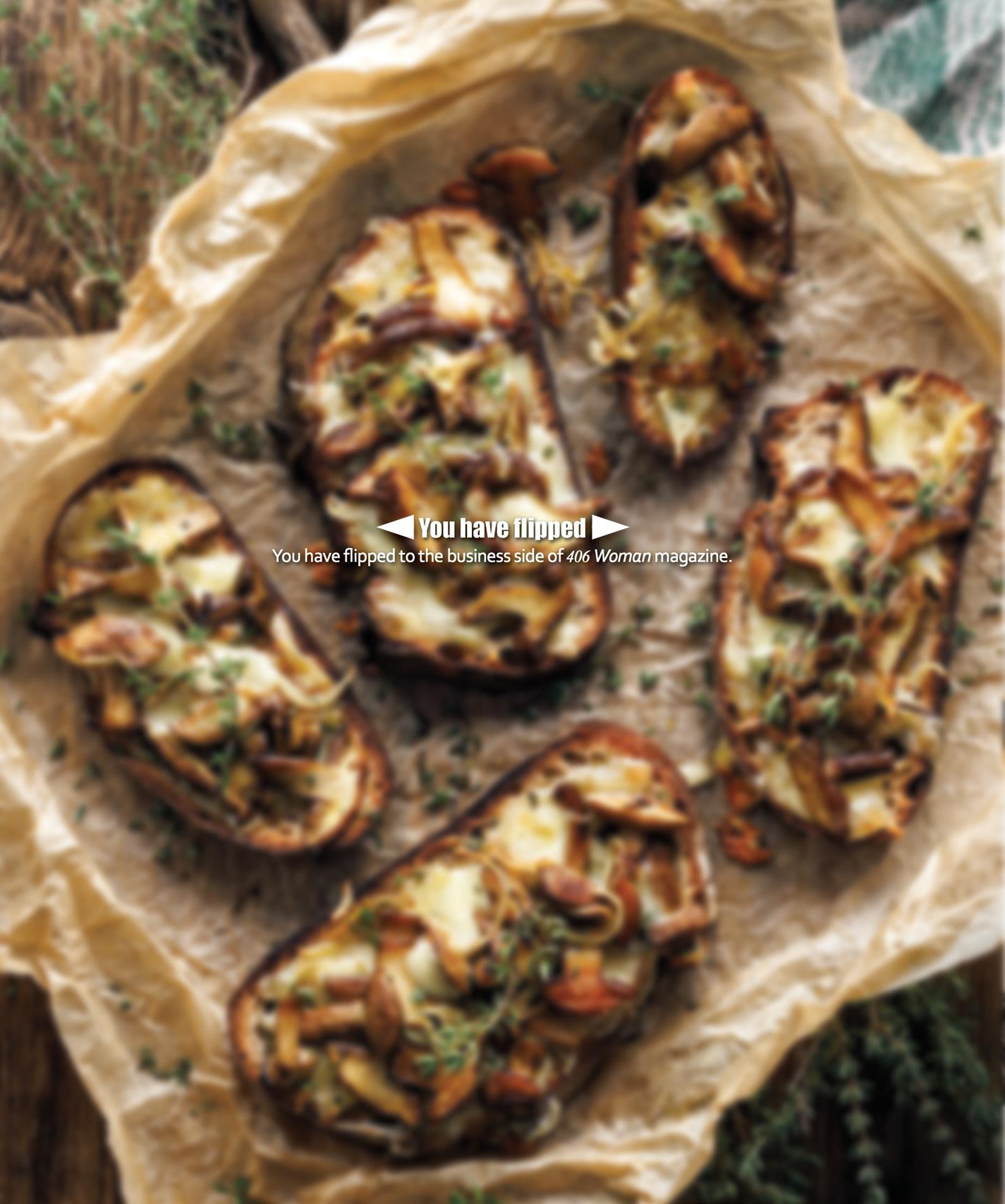
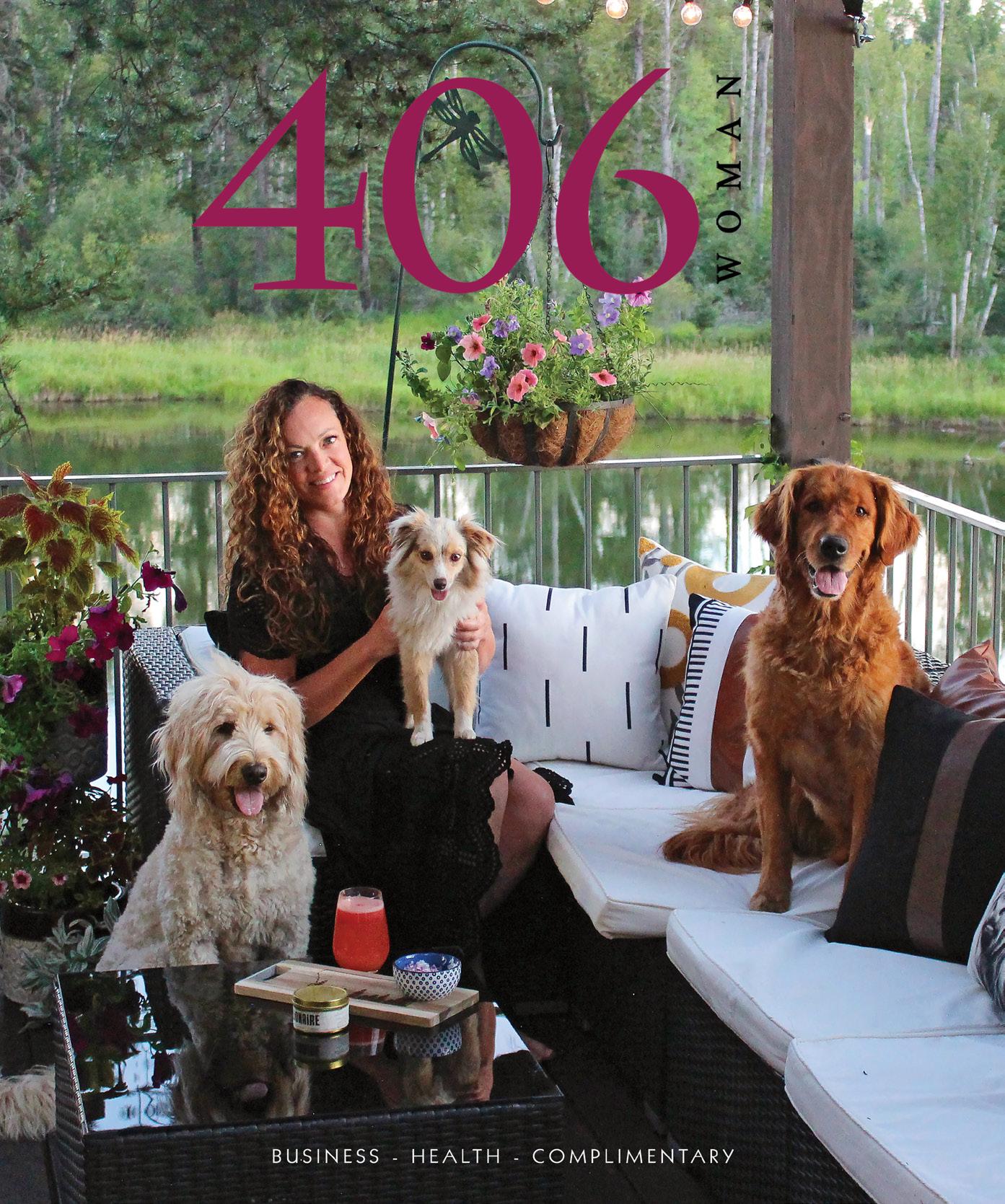


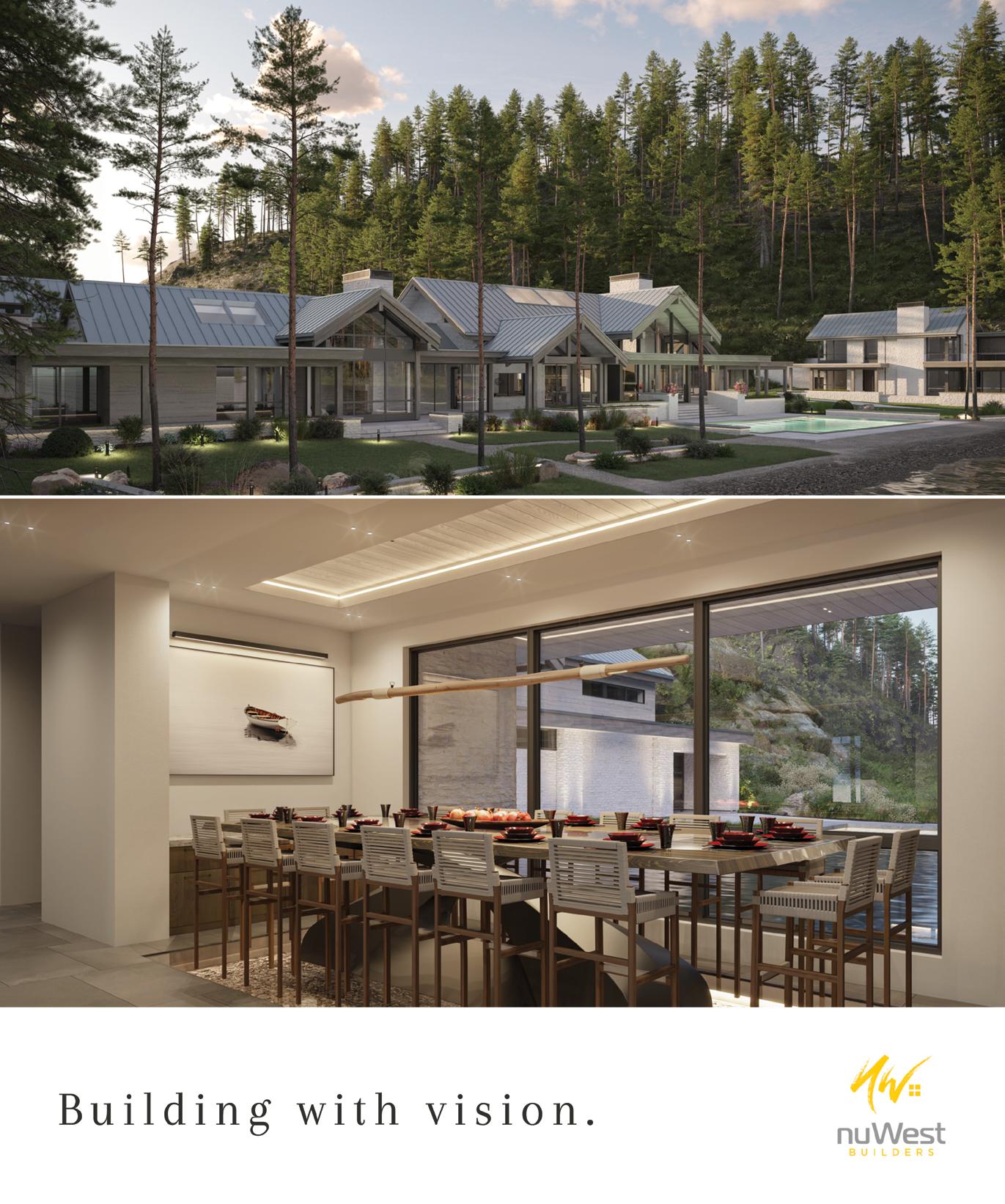
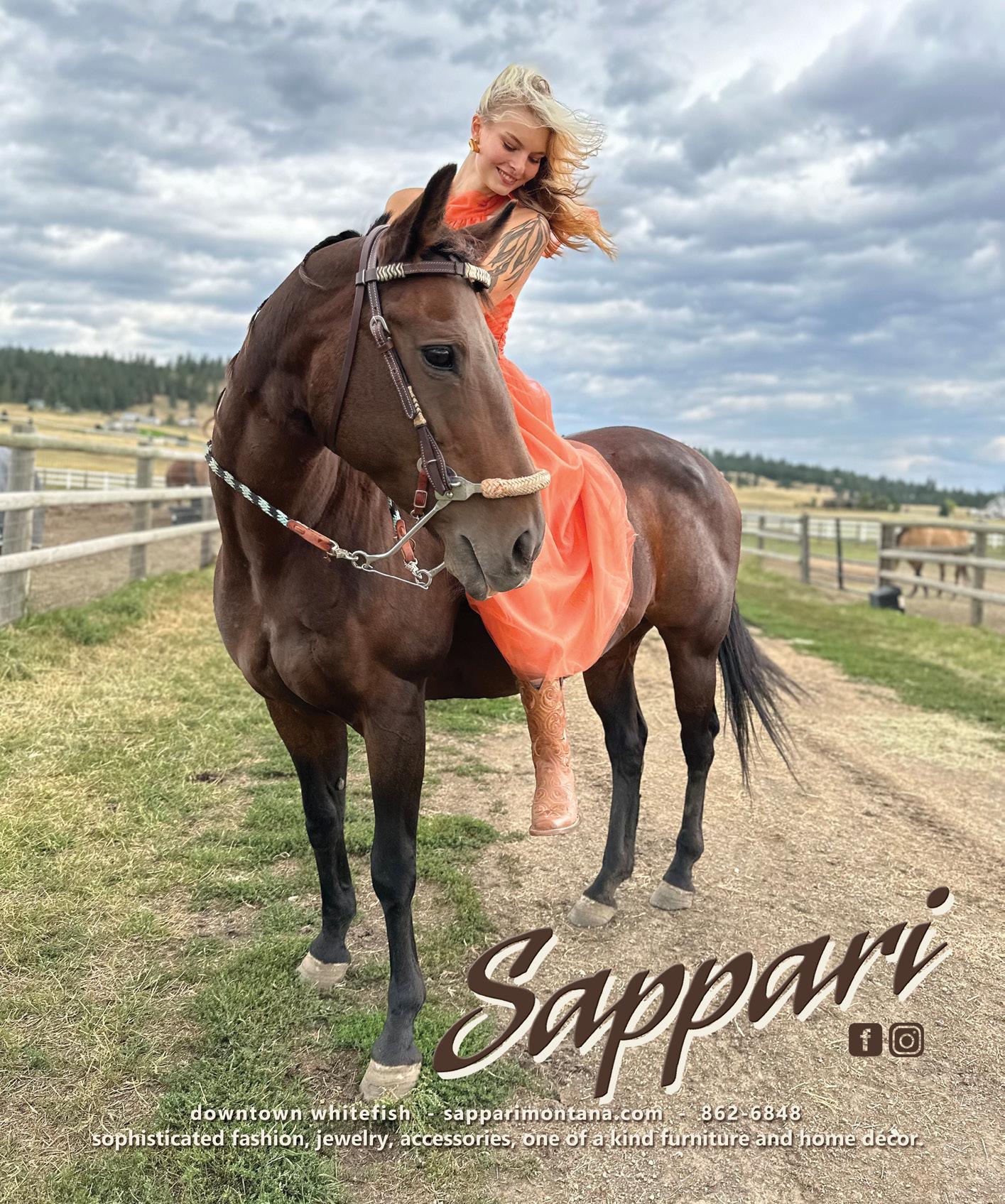









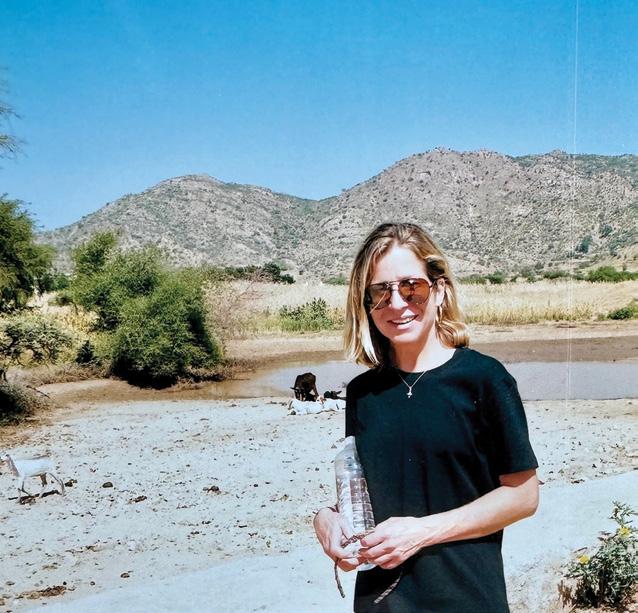
Story by Lucy Smith - Photos provided by Lucy Smith & Sarah Rolfing
“Take my picture, and never forget me.” Words spoken by a village elder in Eritrea, Africa that Lucy Smith remembers to this day, along with memories of the countless people who captured her heart, and a world of needs that she will never forget.
In 2003, Smith took a volunteer leadership position with an international relief organization in East Africa and spent nearly 4 years in Eritrea, Ethiopia, and Kenya. In Eritrea she trained teachers and principals in 22 rural schools and helped establish a food relief program for orphans. Her chief duties in Ethiopia were to manage operations for a clinic that saw 100+ patients daily, and to drive the clinic’s Toyota Land Cruiser ambulance, which also served as its mobile outreach clinic. In Kenya, Lucy trained the management teams of clinic, orphan care, and food relief operations. In 2008, Smith returned to Ethiopia independently to volunteer in the urban ghettos of Bahir Dar. Her last trip to Africa was in 2018, to work with beloved colleagues in Kenya. Lucy remains connected to Africa as a board member of the
international Women and Children’s Health Association and the Kenya Health Scholarship Committee.
Sarah Rolfing will never forget the people who captured her heart or their great needs, either.
In 2009 she traveled to Kenya as a high school student on a service trip sponsored by the Rotary Club of Sumner, WA. Sarah was “so transformed by the experience” that upon her return, the young high school volunteer co-founded nonprofit Team Agape-Kenya to support development projects in rural, underserved parts of Kenya. For the past 15 years, Sarah has served as the nonprofit’s Executive Director and the Rotary Club of Sumner has been a backbone supporter of Team Agape-Kenya initiatives in education, water, hygiene, and health.
Sarah (age 32) and Lucy (age 71) were introduced in 2015 by Sue Rolfing, Sarah’s mother-in-law and a friend of Lucy’s. Sue connected the two knowing each had volunteered for projects in Kenya and were committed to the health and well-being of women and children
living in Kenya’s rural and tribal communities. Each also had strong affiliations with Rotary Clubs in Washington and Montana.
Despite their age difference, the two women became instant friends and began imagining how they might someday return to Kenya together on a service project that combined their experience and skills.
In 2018, Team Agape-Kenya and local partners launched the Magadi “Jeepline.” Like the Toyota Land Cruiser of Smith’s experiences, the “Jeepline” is a mobile clinic staffed by nurses from local health facilities and community health volunteers, that provides health services and education to rural and tribal communities. In both cases, the mobile clinics reach more than 1200 patients each month, serving primary care needs, administering vaccinations, and providing public education sessions to show communities how to prevent water-borne illness and reduce the transmission of disease.
As a registered nurse with specialization in reproductive health education, Sarah saw an opportunity with the Jeepline outreach to
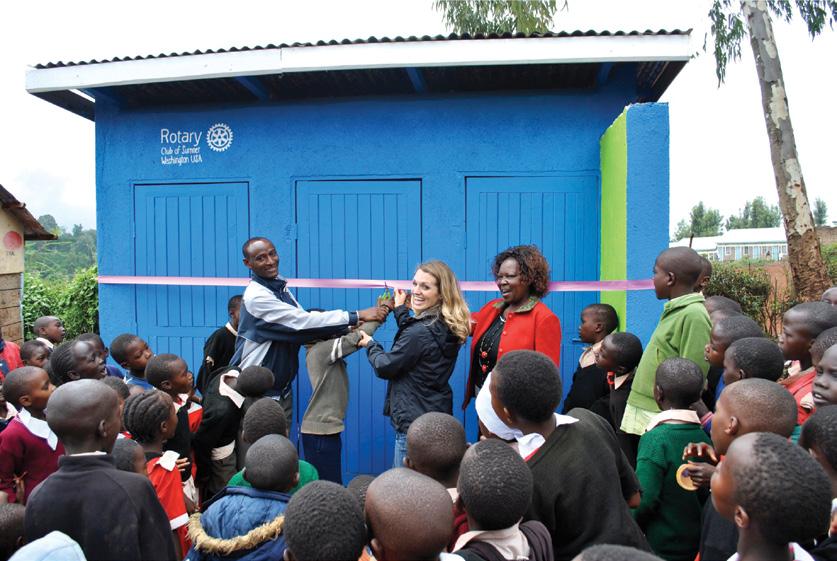

Data suggest that approximately 1 of 5 girls in Kenya between age 15-19 years is either pregnant or already a mother: “Adolescent pregnancy is a key risk factor for school dropout, which is associated with lifelong social, economic, and health consequences, including higher maternal and infant health risks and HIV acquisition.”
provide education to women and teen girls about menstruation and fertility. Lucy proposed adding sessions on basic hygiene and hand sanitation being used successfully in Rotary projects in Guatemala, and the Women’s Health Empowerment Project was born!
Reproductive health education is clearly needed for women and teen girls in the Jeepline service area, where teen pregnancy, school dropout, and missed education due to menstruation are critical issues. Data suggest that approximately 1 of 5 girls in Kenya between age 15-19 years is either pregnant or already a mother: “Adolescent pregnancy is a key risk factor for school dropout, which is associated with lifelong social, economic, and health consequences, including higher maternal and infant health risks and HIV acquisition.” Source: https://online.ucpress. edu/agh/article/1/1/1811306/194929/Pregnancy-trends-and-associated-factors-among
In March 2025, Rolfing and Smith will travel back to Kenya to conduct workshops for teen girls aged 13-18, and Sarah will lead a Health Providers’ Training for nurses who staff the Jeepline. A girls’ boarding school has invited the two to provide fertility education for 250 female high school students, and the Jeepline will bring their workshop to 225 girls and women in Maasai tribal schools. Other schools have also expressed interest in hosting a workshop.
Each participating young woman will receive a “dignity kit” containing reusable menstrual products, CycleBeads, undergarments, soap, and other feminine hygiene supplies. A CycleBead bracelet is a tangible representation of the menstrual cycle
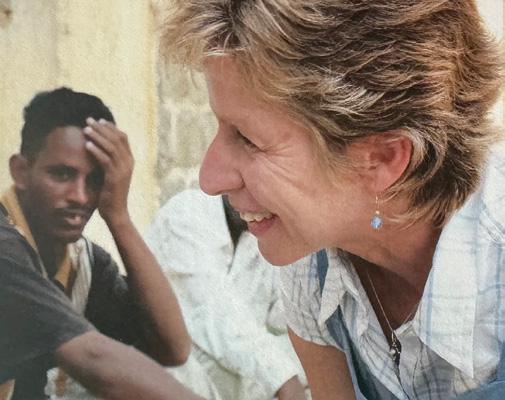
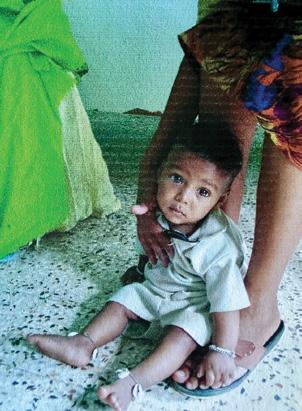
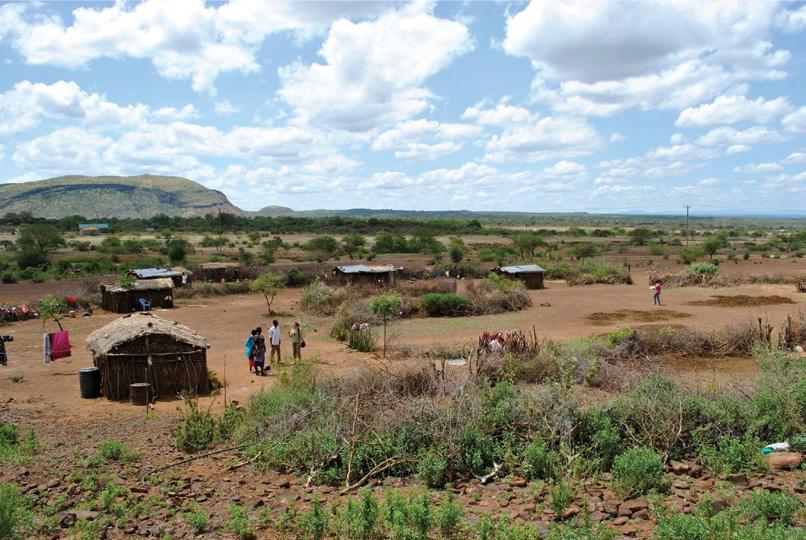



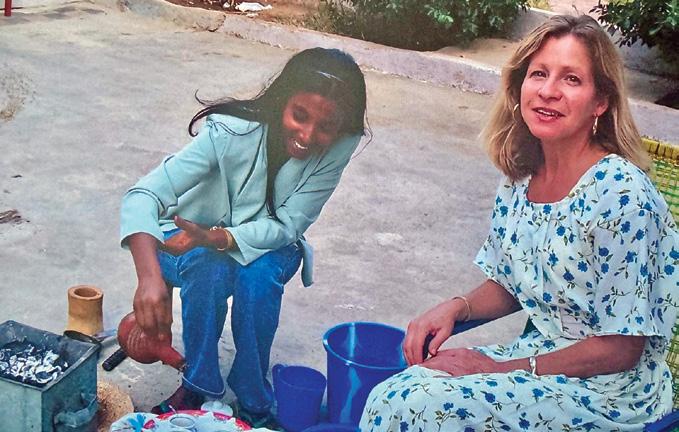
which a woman can wear to track and identify times of fertility based on the Standard Days Method of fertility awareness. When used correctly, this method of fertility tracking can be up to 96% effective in preventing pregnancy naturally. Providing women with fertility education, promotes greater awareness in reproductive health decisions.
When Smith and Rolfing began planning their trip, Sarah teased that they would be very busy stringing together 600+ CycleBead bracelets. Lucy replied that it sounded like a perfect reason to throw some parties! At their invitation, friends and neighbors gathered for wine, appetizers, and the opportunity to make a difference. Not only did dozens of generous girlfriends make 500 perfect CycleBead bracelets, they donated $500 to the project and offered to come back “anytime” for another round of beading.
Meanwhile, women in Sumner, Washington were sewing beautiful shoulder bags for the dignity kits, using materials with Kenyan tribal patterns.

And there was more help…donations from friends and family, an international service grant from Montana Rotary District 5390, and a contribution from the Rotary Club of Sumner will fund all workshop and training materials, facility expenses, fuel for the Jeepline, medical supplies and a budget for on-theground needs at each of the outreach sites (food staples, etc.).
And finally, a call for help… Sarah and Lucy were originally to bring their workshops to Kenya in July 2024, but plans were interrupted by political demonstrations that became increasingly serious, causing road closures and unsafe travel conditions. They want to
use these interim months to “test drive” and fine tune their presentations and hope to enlist teenage girls from Kalispell high schools to be their practice group. They will seek the girls’ feedback to help make the workshop feel as safe, informative, useful, and enjoyable as possible. The Kalispell teens will also have a chance to make CycleBead bracelets for themselves and for girls in Kenya.
Many years ago, two women from different states and different generations traveled to Kenya for different lengths of time to help with different service projects. But from there the story is the same. They worked hard and learned deep lessons about life in ways that only Kenya could teach them. They felt very small in the face of great needs, but their hearts felt bigger than the African sun. They dearly missed loved ones at home but fell in love with the people who welcomed them as sisters and friends. Their lives were changed forever. They traveled to be of service and were themselves served – blessed with love, purpose, and wonder.
Now, they are thrilled to be returning to Kenya on a joint service project. And they can’t wait to see what this new chapter in their Kenya story will teach them!

Scan to give a tax-deductible donation to the Women’s Health Empowerment Project and medical supplies for the Jeepline mobile clinic.




Jessa Ash didn’t start out planning to be a financial advisor, she just always knew she wanted to help people. Even though it’s been a somewhat unconventional journey, it has brought her to where she is today - still helping people.
After earning her bachelor’s degrees in Elementary Education and Psychology (with a focus on autism) in 2011, she worked at a boys home - following her passion for working with special needs kids. She then moved to Hawaii and worked at a private special needs school in Maui. It was beautiful there but, after two years, she moved back to the Flathead valley to be closer to her family. She took a job as a medical coder, (and not being one to do anything by half measures) this led to obtaining her master’s degree in Health Administration. After working in hospital administration for 4 years, she found she was missing the direct connections to the very people she wanted to help.
By Mary Wallace - Photos by Rusty Cash
As she explained her predicament to her cousin, he suggested she pursue a path to become a Registered Investment Advisor at his firm, Fischer Investment Strategies.
Fischer Investment Strategies is a comprehensive financial planning and investment management firm. They are a true fiduciary firm that aligns their investment philosophy with Modern Portfolio Theory - their mission is to achieve the highest expected rate of return, with the least amount of risk at a very low cost for all of their clients. A fee-only Fiduciary Investment Advisor like Fischer Investment Strategies is obligated by law to act in their client’s best interest. This implies they do not receive any commissions or kickbacks from the investments nor custodian.
Jessa has found the niche that will allow her to align with her desire to simply help people achieve their financial goals. She takes pride in the fact that she is working professionally with a team that can help her clients prepare for the
future they envision and have confidence that their investments are safe, transparent, risk appropriate, and will go up over time. Jessa has also assembled a team of other professionals she can refer her clients to - Estate Attorneys, CPAs, Mortgage Lenders, Realtors, etc., so her clients don’t have to navigate their financial planning process alone.
Jessa grew up in Condon, Montana with her father and sister, living off-grid and spending their free time with horses, dogs, cats, and snowmobiles through most of her childhood years. When it was time for the girls to go to high school, they moved to Ferndale so she could attend Bigfork High School.
After leaving Montana for a few years, Jessa moved back to Bigfork. Jessa's life if full of unexpected joys, including the accidental adoption of her goldendoodle, Itsy, followed by Marley, a toy Australian Shepherd, and Gray, a golden retriever. The dogs happily serve as mascots in her articles.

Jessa thrives on collaborating with professionals who are committed to making the smartest financial decisions possible.
Jessa loves traveling and has enjoyed scuba diving in Nicaragua, the Turks & Caicos, Hawaii, and Mexico, as well as bungee jumping in New Zealand and skydiving in Montana. When not working, she hikes with her dogs, goes mushroom picking, snowboarding, horseback riding, and gardening. A self-admitted foodie, her bucket list includes exploring more cultures and local cuisines. Back in Montana, Jessa cherishes the sense of community and is happy to put down roots where friends and neighbors support each other. Despite her adventurous spirit, she draws the line at getting a tattoo—brave, but not that brave!
Jessa thrives on collaborating with professionals who are committed to making the smartest financial decisions possible. She finds particular joy in working with women, empowering them to achieve their financial goals and secure their futures. Jessa believes that comprehensive financial plans are essential for success and is passionate about providing personalized strategies that cater to each client’s unique needs. She specializes in creating and managing retirement plans for businesses, ensuring her clients are well-prepared for their future. Her approach is rooted in fostering strong, supportive relationships, ensuring that her clients feel confident and informed every step of the way.
Jessa’s advice? “Everyone needs a financial advisor, but they also need to make sure they are working with someone who is truly looking out for their best interest. There are achievable steps everyone can take to make better financial decisions, and finding someone you can trust is the best way to get started.”
More information can be found by visiting www.fisfp.com. Jessa is happy to meet new clients wherever is convenient. Give her a call at 406-212-1983, text, or email jessa@fischerinvestmentstrategies.com



By Melissa Dunning
Student interns Makayla (16) and Isabelle (17) are busy working behind a soundboard, adjusting microphones, cameras, and lighting under the pink glow of a neon sign in a small audiovisual recording room. They are preparing to conduct and record an interview with Marianne Smith, CEO and Co-Founder of Code Girls United, for the podcast “Code Girls on Air.” Back in the fall of 2016, Makayla and Isabelle first met Marianne at Sykes Diner in Kalispell, along with 26 other young girls, as they embarked on their coding journey armed with laptops and curiosity. Marianne, alongside Beth Schecher and Elizabeth Brenau, mentored the students in an after-school program that provided hands-on experience in computer science, coding, and business principles. They admittedly were “figuring it out as we were going along.” Fast forward eight years, Makayla and Isabelle have consistently been involved with Code Girls and are now employed as interns. This flourishing organization has impacted over 1,300 girls throughout Montana, expanding to offer various opportunities such as internships, leadership training, scholarship opportunities and even a student-produced podcast.


This opportunity enables students to engage with industry experts and offers scholarship awards for top-placing teams. For some students, this is their first encouragement to further their education after high school.
The Problem
Today, women have more opportunities in the tech industry, with many barriers from the past removed. However, the tech sector remains heavily male-dominated, posing the question: Where are all the women? In the mid-90s, women filled 36% of computer science roles; this number has dwindled to a mere 21% today despite a 100-fold increase in computer science jobs. Various factors contribute to this decline, such as lack of early exposure to technology, male-centric programming, the appeal of computer gaming as an introduction to programming, and the emphasis on robotics in high school computer science education. In Montana, Computer Science is not a requirement for high school graduation, which compounds the lack of resources for female students, particularly in rural and Tribal areas where resources are even more sparsely available.
Code Girls was founded by trailblazing women who navigated the male-dominated tech industry, setting the stage for future generations of women. With a wealth of experience in technology and encountering workplace discrimination, these women gather to reminisce and sometimes humorously recount past incidents, many of which were serious. Conversations cover a variety of topics, from outdated dress codes and intrusive inquiries
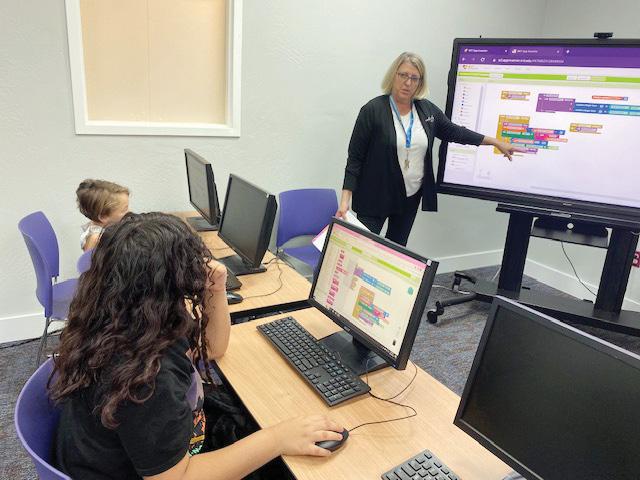
about family planning during interviews to gender-based pay disparities and approaches to address ongoing sexual harassment. These women aimed to challenge the established norms in the Technology Sector's early days, paving the way for girls to receive support and increased opportunities in technologyrelated fields.
Code Girls United aids girls in rural and Tribal communities by providing educational resources in computer science and business through after-school programs and initiatives. These programs are led by local women who double as role models and mentors for students. The program's innovative approach combines technology and business, emphasizing problem-solving skills. Participants learn coding and business basics in the first half of the year and collaborate in teams to develop functional apps addressing community issues in the second half. Projects have tackled diverse topics like environmental conservation, mental health, and supporting marginalized groups. The students then form business plans, conduct market research, and strengthen their presentation and interview skills. Every year, students participate in an “App Challenge” where they showcase their
newly acquired skills by presenting their apps in an organization-wide competition. This opportunity enables students to engage with industry experts and offers scholarship awards for top-placing teams. For some students, this is their first encouragement to further their education after high school.
So much more than just computer science and coding/programming, Code Girls United creates an environment for girls to develop selfconfidence, self-efficacy, and interpersonal skills that are often not intrinsic in school day curriculum and activities. This support helps to broaden their skills and boosts their confidence for future endeavors. Multiple teams from CGU have participated in the Congressional App Challenge, with winning teams consecutively for two years and others securing 2nd and 3rd place. As a result, these students earned the chance to travel to Washington DC to showcase their projects in the Capitol Building during the National Science Fair. Isabelle from “Code Girls on Air” was part of one of these winning teams. She stated in an interview: “Since I started at CGU, I have become much more confident in who I am and what I can achieve. I started out very shy, but I have been empowered to step
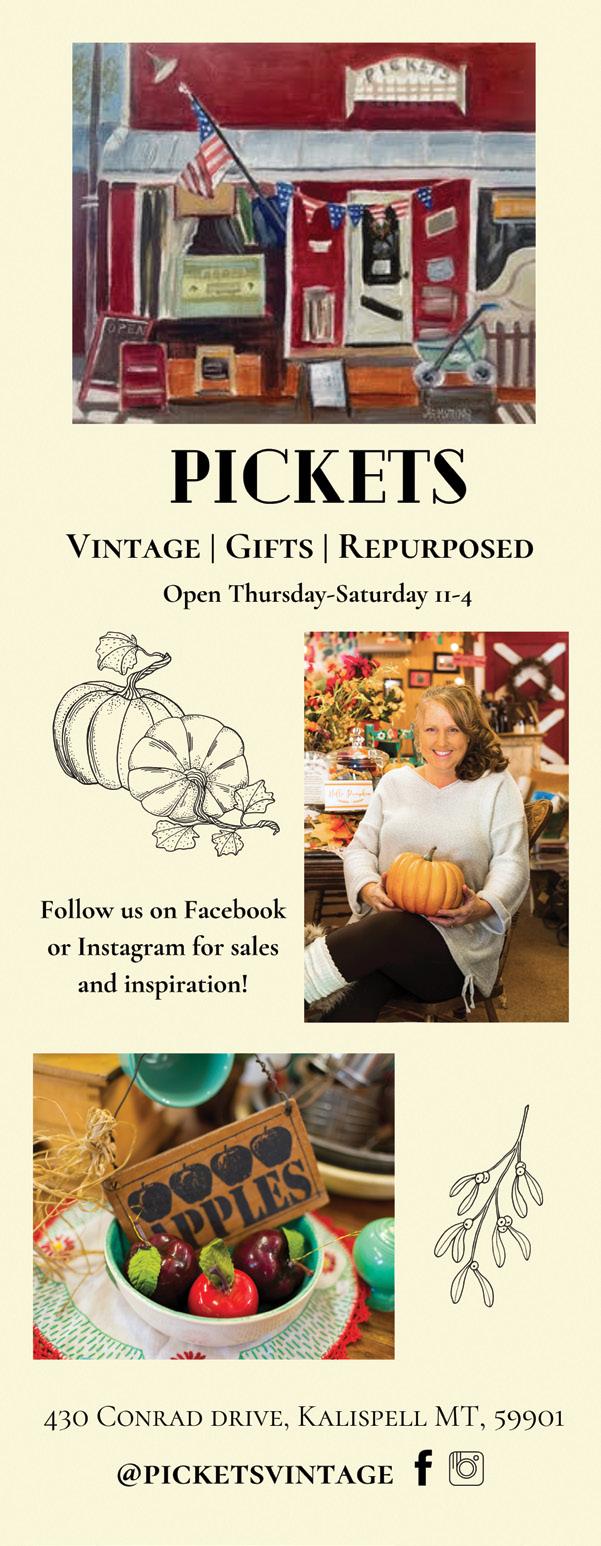
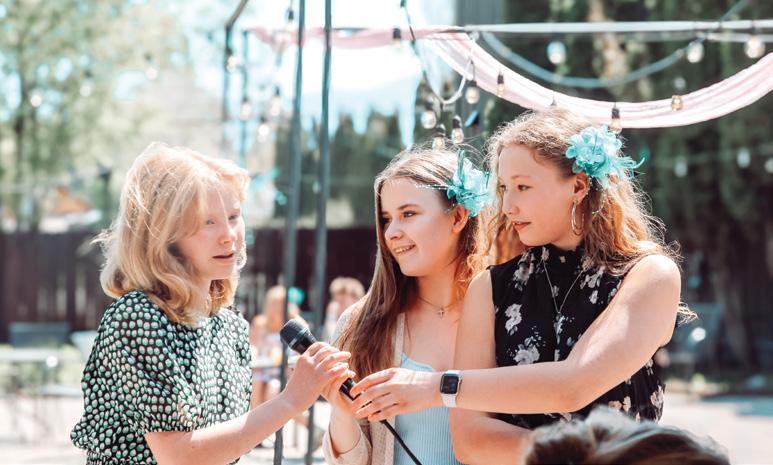
outside my comfort zone to do things I never thought I could do and has given me the confidence I need to achieve my goals.” This kind of testimony exemplifies the impact the organization aims to have on each of its students.
Code Girls United is just starting with 44 programs throughout the state including Kalispell, Whitefish, Eureka, Libby, Helena, Great Falls, Harlem, Billings, Bozeman, Polson/Ronan and Browning. With each passing year enrollment grows, and the organization offers more opportunities by creating new programs that deepen their experiences. Students can continue to more advanced classes and engage as class aids and mentors to younger students, bolstering the vital intergenerational relationship-building for women and girls. Soon, a wave of young women will enter college or careers equipped with the skills needed for high-paying flexible jobs in technology.

Code Girls United relies on fundraising and women committed to shaping a brighter future for the upcoming generation. The organization thrives thanks to a diverse group of women – some with extensive technical backgrounds and others with none – who step up to teach, volunteer, or mentor with a shared eagerness to learn and contribute. Annual fundraising events include a Mother-Daughter Tea Party, Sip, Savor, Code wine pairing event, and participation in the Whitefish Community Foundation Great Fish Community Challenge. Code Girls United needs financial support from individuals who are enthusiastic about empowering girls to shape their own futures through coding.
To learn more visit: www.codegirlsunited.org or email m.smith@codegirlsunited.org. You can also call Marianne Smith directly at 406407-0201. We invite you to listen to the “Code Girls On Air” podcast on Spotify or Apple Podcast.




By Jessa Ash
Market volatility can leave investors feeling like they are on a roller coaster ride, and many of you may have experienced a wild summer! The cries of market concern have been easy to hear this year, and having the discipline to not react to them can be challenging. Those who are effectively diversified, though, can experience a much smoother ride (which, if you are anything like me, really helps keep the blood pressure stabilized and anxiety levels down). So, in the name of heart health and mental stability, how does one diversify their portfolio?
Investment diversification is a cornerstone of effective portfolio management, aimed at reducing risk and enhancing returns. By spreading investments across various asset classes, sectors, and geographies, investors can mitigate the impact of poor performance in any single investment. Diversification involves allocating investments across different asset classes, such as stocks, bonds, real estate, and commodities, to reduce exposure to any single asset or risk. The rationale behind this strategy is that a diversified portfolio is less likely to experience significant losses because the positive performance of some investments can offset the negative performance of others. The primary benefit of diversification is risk reduction. By investing in a variety of assets, investors can protect their portfolios from significant losses. For example, if the stock market experiences a downturn, investments in bonds or real estate may remain stable or even
increase in value, balancing the overall portfolio performance. Diversification also helps in achieving more stable and predictable returns over time. While individual investments may be volatile, a diversified portfolio tends to have smoother performance, reducing the impact of market fluctuations.
By spreading investments across different asset classes, investors can preserve their capital. This is particularly important for conservative investors or those nearing retirement, who may prioritize capital preservation over high returns. Diversification allows investors to tap into various growth opportunities across different sectors and regions. This can lead to higher overall returns, as different assets may perform well at different times. Obviously, diversification takes a bit of work which a lot of investors simply do not have the time, nor wherewithal, to maintain.
Fischer Investment Strategies (FIS), a fiduciary, investment management and financial planning firm, understands the importance of diversification in achieving long-term financial success. Their approach to diversification is tailored to meet the unique needs and goals of each client. They begin by assessing each client’s risk tolerance, investment goals, and time horizon. Based on this assessment, they create a personalized asset allocation strategy that spreads investments across various asset classes, including stocks, bonds, real estate, and alternative investments. Whether the goal is capital preservation, income generation, or growth, their diversification strategies are tailored to meet these needs.
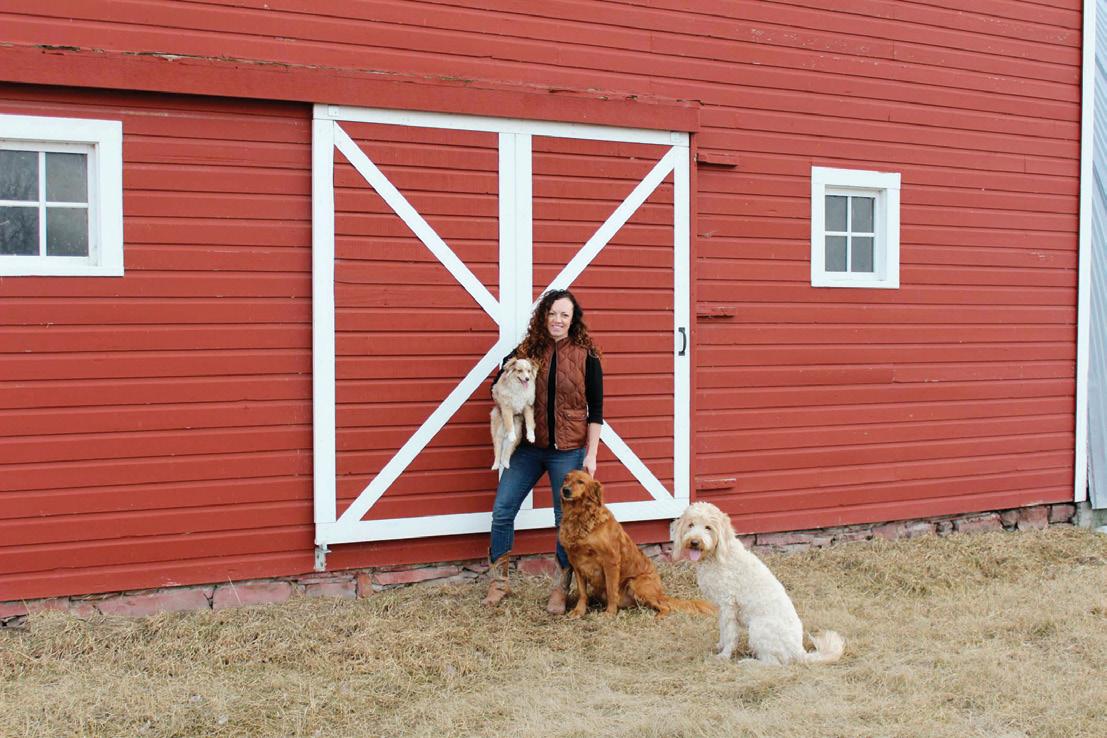
Investment diversification is a cornerstone of effective portfolio management, aimed at reducing risk and enhancing returns. By spreading investments across various asset classes, sectors, and geographies, investors can mitigate the impact of poor performance in any single investment.
FIS ensures that clients’ portfolios are not overly exposed to any single country’s economic risks. By including international stocks and bonds, they help clients benefit from global economic growth and reduce exposure to domestic market risks. Within each asset class, they diversify investments across various sectors. This approach ensures that the portfolio is not overly reliant on the performance of a single sector.
Over time, the performance of different assets will vary, potentially altering the original asset allocation. FIS rebalances clients’ portfolios to ensure they remain aligned with their risk tolerance and investment goals. Their team of experts
continuously monitors market conditions and adjusts clients’ portfolios as needed to optimize performance and tax loss harvesting.
Investment diversification is a powerful strategy for managing risk and achieving long-term financial success. As you can see, it takes time and dedicated research. Fischer Investment Strategies is committed to helping their clients achieve their financial goals by having a low cost, tax efficient, globally diversified portfolio, utilizing their EvidenceBased Investment Philosophy.
Jessa Ash, Registered Investment Advisor Fischer Investment Strategies 406-212-1983 - jessa@fisfp.com



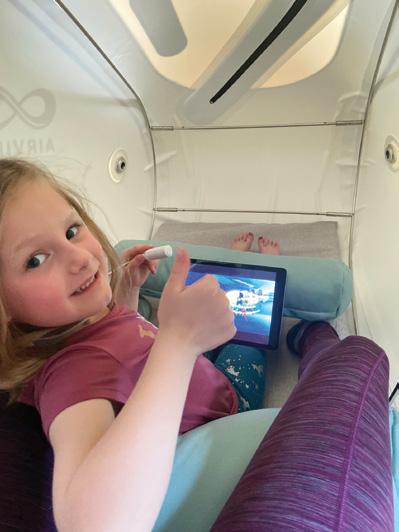
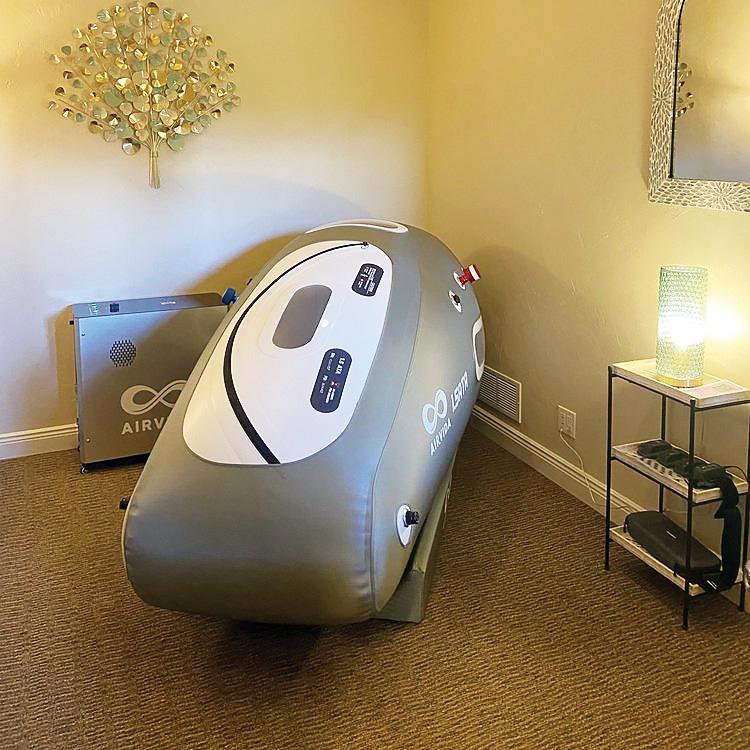

A Conversation with Amanda Arguello Edited By Mary Wallace - Photos provided by Equinox mHBOT
In today’s stressful economy and busy world, frustrations are magnified when chronic pain and health ailments interfere with our work and quality of life. Many are actively seeking holistic or alternative options - not necessarily to replace their traditional medical treatments, but to compliment them by accelerating results and increasing accessibility.
Equinox mHBOT and Beyond, a new clinic located in the shared professional building at Cloud 9 in Kalispell, is driven to serve up the latest in combined wellness therapies. Locally owned and operated by Amanda Arguello, a Pre-Medicine Biology major and more recently tenured corporate software trainer that underwent a randomized corporate layoff, she understood that traditional Western medicine was not addressing the core of most health concerns and felt compelled to “dive deeper.”
“My introduction to HBOT (hyperbaric oxygen therapy) began two and a half years ago when covid-vaccine injured pro mountain biker, Kyle Warner, shared his story via webcast. Upon completing the accelerated (daily) 40-session protocol, his almost non-existent energy levels were renewed and he was able to return to his profession and training regime. It led me down a rabbit hole and opened the door to over 150 health indicators and my own hyperbaric journey. With just a few sessions I felt an increase in energy, improved sleep, and significant chronic pain relief. This was a welcome improvement to life as a single mom, working a stagnant home-based software tech job for over a decade.”
Hyperbaric therapy has a long history (over 300 years) of clinical applications and engineering feats, including a 5 story “Steel Ball Hospital” built on the banks of Lake Erie in Cleveland, Ohio in 1928. It facilitated 60 rooms of comfortable accommodation for hyperbaric patients during the Spanish Flu outbreak. Covid has increased awareness about this highly effective, non-invasive, and natural treatment.
The health indicator list is extensive, the science is simple, yet it is practically ignored by western medicine and undergoes strict FDA regulation, since oxygen is considered a drug. Technological advancements and the use of oxygen concentrator machines, instead of pure oxygen tanks, has made hyperbaric chambers portable and publicly accessible. With mild (under 1.5 atmospheric absolutes) hyperbaric clinical research stacking up, it is proving that soft chambers are just as effective with the bodily response of achieving cellular regeneration across all bodily systems. Protocols vary depending on the health concern but range from twice a
day (with a 4-hour break), 20-40 sessions, and/ or weekly maintenance and recovery sessions for athletic performance and chronic pain.
“Cellular regeneration, viral infection and cancer remission are on the long list of potential recovery from “uncurable” diseases and I’ve seen amazing gains in mobility from Lupus vasculitis nerve degeneration after just one session. While my mother’s breast cancer oncologist gave me a blank stare when I mentioned hyperbarics, it was a useful conjuctive therapy to help her energy and sleep through 12 weeks of chemotherapy, and her body will recover faster once she undergoes a lumpectomy. Autism is another indicator for quick results and improvements in social behaviors and sleep patterns. We’ve also heard about professional athletes and celebrities getting chambers for home use for injury recovery and collagen and skin rejuvenation.”
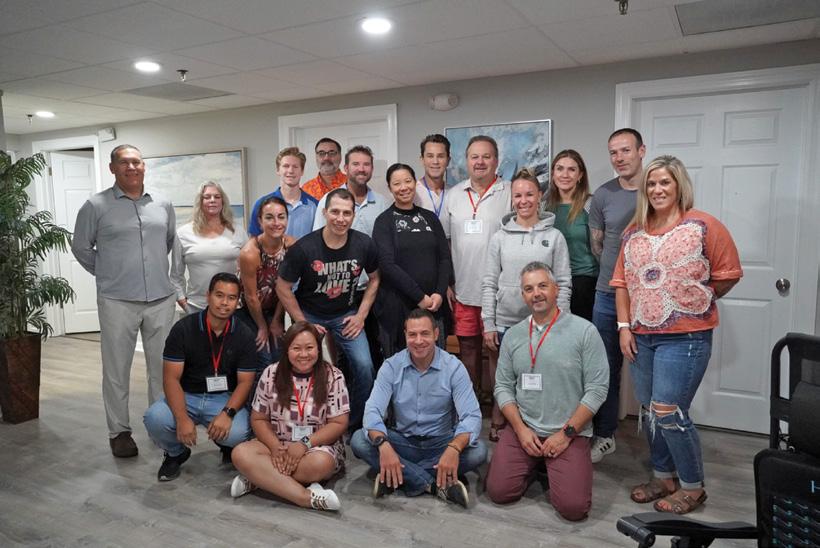

Above photo: Former UFC champ Matt Hughes (ongoing hyperbaric therapy for TBI and physical training recovery from his train wreck accident in 2017) On right: The group picture of the hyperbaric technician certification course in New Jersey. Including a Vegas family practice doctor, functional medicine clinicians from Florida and Alabama, and attendees from the UK and Philippines.
Our bodies truly heal when they are nourished from within and not masked with pharmaceuticals and the long lists of risky side effects and dependency.
Studies support that mild hyperbaric ranging from 1.2 – 1.5 ata (atmospheric absolutes where 1.5 is 50% more than normal atmospheric pressure at sea level) and 95-97% oxygen, results in benefits comparable to hard chamber versions at 2.0 or higher ata that typically use pure oxygen in medical facilities. Each person is unique in their comfort levels with the pressure and how their bodies sustain hyperbaric benefits, and mild hyperbaric in-home use allows more flexibility in attuning to your own body and making sure the benefits are attainable between busy work and family life schedules.
Our bodies truly heal when they are nourished from within and not masked with pharmaceuticals and the long lists of risky side effects and dependency. mHBOT is not a regimen that demands hours at the gym, strict dieting, or high-priced supplements. It can also be used conjunctively with red light therapy, ProImmune (Glutathione amino acid precursor supplement), and electromagnetic devices to magnify the healing effects. Regeneration of stem, nerve, immune, and glial cells allows our bodies to function at optimum levels and rejuvenate from the inside out - facilitating longevity, naturally.
The ability to utilize electronic devices in the soft chamber (very minimal risk of spark and the highly publicized ‘risk of explosion’) allows users to continue working from their laptop, entertain during kidfriendly co-sessions, or even achieve relaxation through sound therapy or meditation.
As non-traditional treatment options are becoming more widely adopted and clinically proven, we all need to remain mindful of products and services that falsely claim to share the same impact. It is still highly recommended to consult with your primary care physician when embarking on any complementary or alternative treatment plan. Building bridges within a community of educators and wellness advocates is essential to our general safety and positive outcomes.
“I am currently networking with veterans, practitioners, clinicians, school system admins, nonprofits, and families to create a platform for cross-generational and community collaboration. Having an extensive corporate software background in adult learning and customer support, has driven my passion for seeking a work/life balance and creating a home life that fosters wellness and continual growth throughout all stages of life. Truly listening and caring for patients and clients on an individual basis is at the heart of my efforts and clinical therapies. The Flathead valley
stimulates adventure and a passion that expands beyond the scope of living to survive, into living to give back and thrive.”
Amanda is actively seeking to expand with a hard chamber setup for more aggressive health indicators and clients with mobility issues. This requires a licensed practitioner willing to add to their practice or who may be ready to retire and join the hyperbaric accessibility efforts with a clinical director role.
“For anyone interested in collaborating clinical setup, outreach programs, or conjunctive therapies, please don’t hesitate to contact me.”
Amanda Arguello
Equinox mHBOT & Beyond Founder / Hyperbaric Technician - Equinoxhbot.com (406) 261-5555

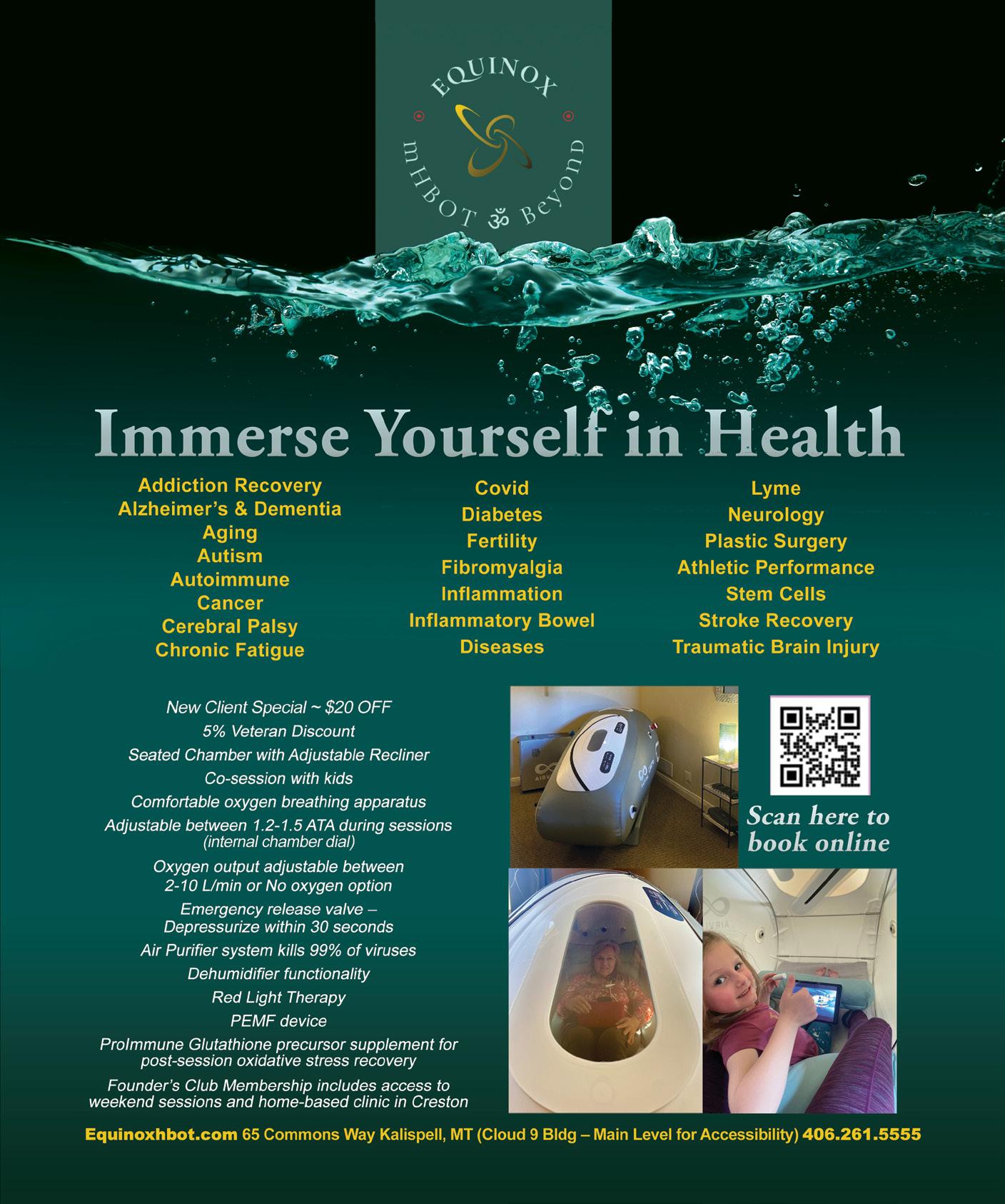

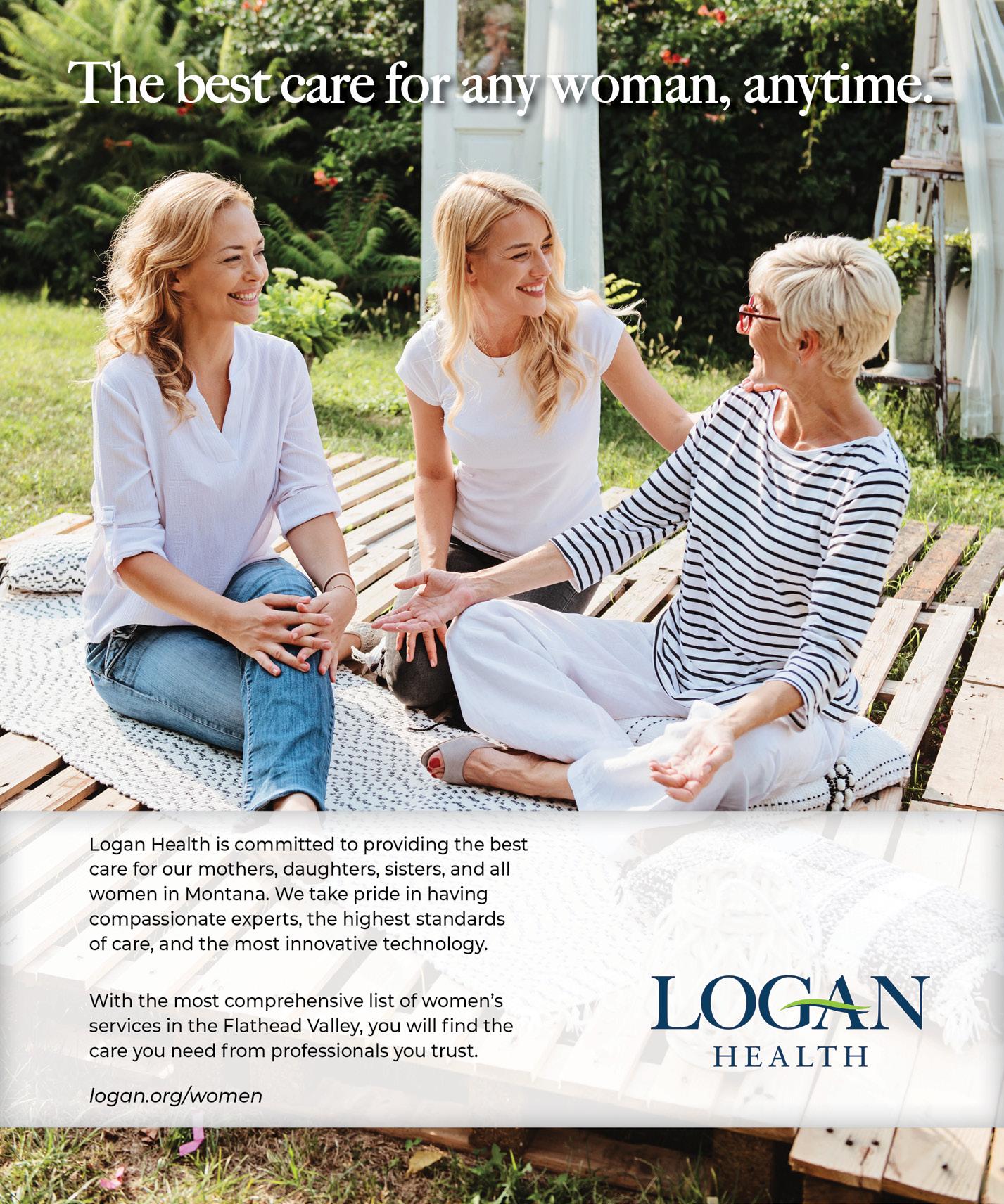
What brought you to the Flathead Valley?
I was born and raised in Paducah, Kentucky. Before my mother passed away from a malignant brain tumor, she told me that I would make a great nurse, which led me to the field of nursing. I have been a nurse for over 30 years and have spent most of my nursing career working with women and men diagnosed with breast cancer. I found the position at Logan Health for an Advanced Practice Provider at the Breast Center, so I applied, accepted, and then arrived here in January of 2024.
What is your specialty of practice?
I’ve spent my entire career in oncology. I worked as a bedside nurse on the myelosuppression/bone marrow transplant unit at Vanderbilt University Medical Center. After receiving my Acute Care Nurse Practitioner certification, I accepted a position as a radiation oncology nursing practitioner in Arkansas. In 2000, I relocated to Texas and worked at M.D. Anderson Cancer Center, Memorial Hermann Health System, and Houston Methodist. I graduated with my doctorate in nursing in 2015.
How did you get into breast surgical oncology and diseases of the breast?
Since beginning my career in oncology, my work has led me to this role, and I’ve developed a special interest in breast cancer and diseases of the breast. At Logan Health Breast Center, I see all kinds of patients: those with breast cancer, those at high-risk, patients with a family history of breast cancer, and patients with benign diseases of the breast.
What is the most rewarding part about your job?
My patients motivate me daily. As someone who has family history of cancer – a mother with brain cancer, maternal grandmother with breast cancer, a maternal uncle with leukemia, and my father who recently completed chemotherapy for bladder cancer, I see the impact that a cancer diagnosis has not only on the patient but the family as well. All of the amazing women and men who have been diagnosed with cancer have taught me the meaning of life and what it means to be a survivor. Without them, I would not be the practitioner that I am today.
How do you like to spend your free time?
I enjoy spending time with my family and friends, traveling to new places, attending sporting events, and being outdoors. We had the opportunity to visit China when we adopted our son. I have been to Ireland, Iceland, Belize, Mexico, Jamaica, and the Cayman Islands. Next up…Alaska and Italy. I also love rooting for the Houston Astros and the University of Kentucky Wildcats!

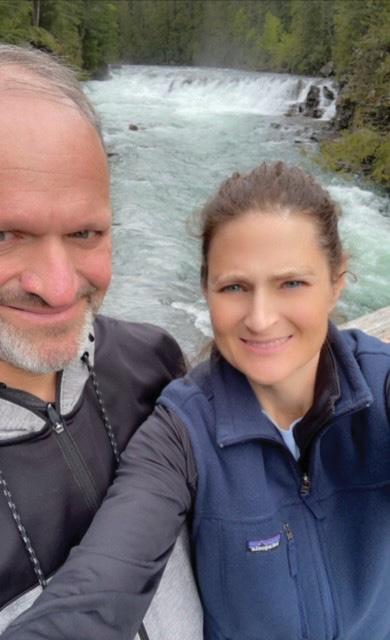
Brought to you by




By Chris Leopold - Photos provided by Logan Health
In January 2024, Brittany Williams, a 34-year-old mother of three, visited urgent care for an eye condition when she also brought up to her provider that she had been experiencing breast pain for months. While no lump was detected, her provider recommended a precautionary mammogram. Although breast pain is not commonly associated with breast cancer, especially in an early stage, the imaging coincidentally revealed an area of concern. Further testing and a biopsy confirmed the diagnosis.
Brittany is far younger than the typical breast cancer patient in the United States, where the median age of diagnosis is 62. “They called and said, ‘I hate to do this over the phone, but you have early-stage breast cancer,’” Brittany recalled. “I had already prepared for the worst, so it was a bit of a relief to know. But my family didn’t take it as well. There was a lot of anxiety.”
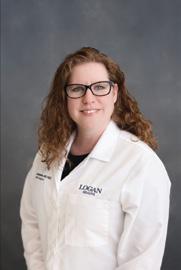
Brittany was diagnosed with DCIS (ductal carcinoma in situ), an early form of breast cancer where cancerous cells are present but haven’t yet formed a lump. Despite the diagnosis, Brittany felt fortunate to have caught the cancer at such an early stage. DCIS is con-
sidered Stage 0 for breast cancer, meaning that it is in its earliest form and is non-invasive.
Brittany was referred to Dr. Melissa Kaptanian, breast surgeon at the Bass Breast Center at Logan Health Medical Center. Together, they developed a personalized treatment plan. “We have something called shared decision making, which is where we talk through all the options that she has,” said Dr. Kaptanian. “I tell patients I am the information lady and they are the decision lady. We are going to figure out what option works best for them. There is no cookie cutter medicine that is right for every patient.” Not only was Brittany fortunate to have caught the cancer early, she was thankfully healthy and therefore had a variety of treatment options to choose from.
After considering all the options, she chose to undergo a bilateral mastectomy, a procedure that removes
both breasts. “I figured I’m done having kids, I’m done nursing, I don’t need them. A lot of people asked if I was sure, but I didn’t want the cancer to spread. This felt like the right choice for me,” Brittany said. While no treatment can guarantee cancer won’t return, a bilateral mastectomy significantly reduces the chance of recurrence.
Part of Brittany’s decision-making process also involved considering reconstructive surgery. She was referred to Dr. Thomas Wright, plastic and reconstructive surgeon at the Logan Health Surgical Clinic. Like Dr. Kaptanian did with the treatments,
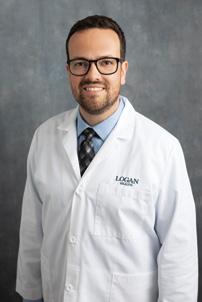
“I tell patients I am the information lady and they are the decision lady. We are going to figure out what option works best for them. There is no cookie cutter medicine that is right for every patient.”
Dr. Wright explained all the options available to Brittany for reconstructive surgery. Women who undergo mastectomies generally have three choices: remain flat, get implants, or choose tissue-based reconstruction. For Brittany, maintaining her natural breast image was important. “When I met with Dr. Wright, I didn’t know much about the tissue-based option,” she said. “But the more I learned, the more I felt it was right for me. I have a history of my body rejecting things, so using my own tissue seemed like the best choice for me.”
The most common tissue-based procedure is the DIEP (Deep Inferior Epigastric Perforator Artery) flap reconstruction. This method uses tissue from the lower abdomen to rebuild the breasts. Patients often find this method to be more comfortable because the tissue from the abdomen is soft and pliable, similar to breast tissue. “A lot of people choose tissue-based reconstruction to avoid implants,” explained Dr. Wright. “They prefer the more natural option, and it often requires no additional surgery, unlike implants which may need revisions after 10-15 years.”
In June, Brittany underwent the DIEP flap procedure to rebuild her breasts. An incision was made on her lower abdomen from hip to hip, just below the belly button, in a similar manner to a tummy tuck. The tissue was then transplanted to her chest and shaped into new breasts. The surgery took about ten hours, and Brittany stayed in the hospital for three days. “After that procedure we need to do frequent flap monitoring,” continued Dr. Wright. “Patients who have this procedure done will experience a sore abdomen so we ask that they don’t do any heavy lifting for about six weeks. Generally by that six-week mark, they are back to normal.”
Timing was critical in Brittany’s case. From her initial mammogram on January 16 to her biopsy on January 23, she quickly met with Dr. Kaptanian by January 30 to discuss treatment options, and with Dr. Wright on February 6 to plan her reconstruction. By February 14, she underwent a bilateral mastectomy. In less than a month, Brittany had gone from the initial screening to a bilateral mastectomy. The quickmoving process not only solved the life-threatening diagnosis but also helped bring quicker ease to her family.
Logan Health’s multidisciplinary approach ensured that Brittany received top-tier care at every step of her journey. The Bass Breast Center, a nationally accredited facility, requires its multidisciplinary teams to thoroughly review each patient’s case. In Brittany’s case, Dr. Kaptanian, Dr. Wright, and their teams, along with radiologists, pathologists, and nurses, collaborated closely to ensure she received the best possible outcome. “I recommend that whole team,” Brittany said. “They did a wonderful job, and I wouldn’t be where I am today without them.”
While the American Cancer Society advises women at average risk to begin screening at age 40, understanding individual risk is key. Women with close relatives who developed breast or ovarian cancer at a young age may face higher risks and should be screened sooner.
Though Brittany’s early detection was somewhat of an anomaly, her story highlights the importance of self-awareness and proactive health management. Dr. Kaptanian emphasizes three main takeaways: “Starting mammograms younger isn’t the lesson here because, in general, breast cancer wouldn’t have been picked up at such an early stage. The key is establishing a primary care provider, understanding your risk based on family history, and practicing total body self-awareness.”
For Brittany, this proactive approach to her health was just part of who she is. Her attentiveness to her own body and decision to seek medical advice were critical in catching her cancer early.
“Life is short,” Brittany advised. “Listen to your body and do everything you can to take care of it.”

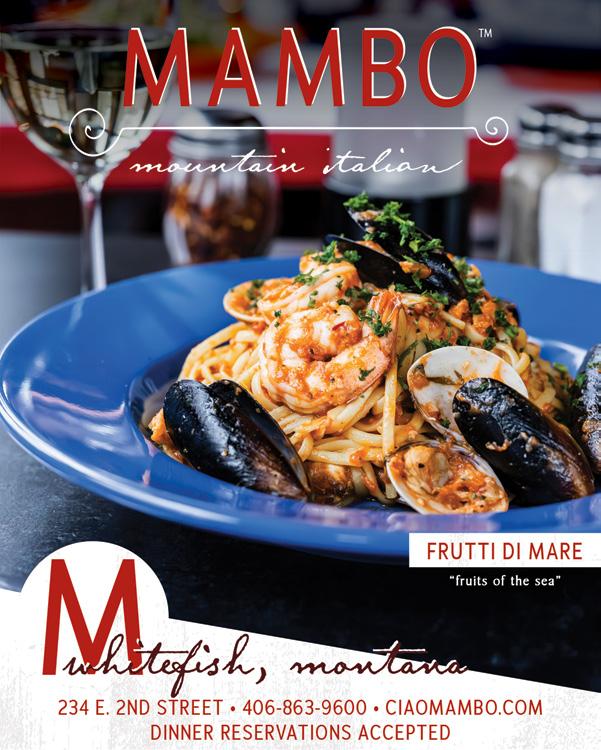


Written by Austin Rusher, WHNP

Being a girl is hard. Being a woman is also hard. Figuring out who we are, what we like, what we do not like, what our boundaries are etc. is an entire process that changes as we mature and grow as an individual. To make matters worse, there are often no clear guidelines and the most influential and easily accessible outlets often do not have our best interests in mind. The media, for example, broadly implies that women are unworthy if their Body Mass Index (BMI) is too high. Society and the media assume a women’s preferences, or that their decisions and/or lifestyles are “debatable” or “open to persuasion.” Historically women have been shamed, encouraged, or even groomed to believe this as well.
Today, we are going to tackle a few areas of confusion often encountered in medicine, or disclosed during a “doctor’s” visit, and hopefully shed some light on some grey areas. One topic, that I believe should be included in every young woman’s annual appointment, birth control counselling consultation, or period management visit is consent. By now, most readers are familiar with Larry Nassar (especially relevant as the 2024 Olympics just wrapped up in Paris) and the despicable abuse that he carried out on adolescent and young female athletes. Nassar abused his position of authority as a doctor, and as a trusted male adult, to sexually abuse these athletes for years, and arguably, right under the public eye. Those same brave, young, female athletes exposed him and he was held accountable for his crimes and is currently serving time in prison. These types of situations are unacceptable and women need to feel empowered and believed when, unfortunately not if, these events occur.
Nowadays, I often have parents of young patients, past the age that a provider assesses for normal physical development BUT less than 21 years of age and young patients themselves, ask when they need their first breast or pelvic exams. Under 21 years of age, unless there is a symptom (such as abnormal bleeding, discharge, or pain), or the patient has a chosen method of contraception or period management that requires it, young women DO NOT need a pelvic exam OR a breast exam. Again, before the age of 21 years old, unless you as the patient have
a concern and fully understand the indications for the exam, you should not be asked to take your top and/or pants off for a medical exam. After 21 years of age, the answer is a little more complicated as not all of the medical organizations agree. However, broadly speaking, if a symptom is present, an exam is usually warranted to which the patient may be asked to get undressed to properly address the issue.
Another area of consent that concerns me deeply, is when a patient communicates during their appointment that it is difficult to “get” their partner to use a condom OR they are uncertain if their partner uses a condom. I believe that this is a reflection of their partner’s character. Often the partner is not fully considering the extent of the consequences of forgoing protection for expedited or perhaps a few brief moments of increased pleasure or worse, control. In not wearing a condom, they are putting their partner (and really themselves) at risk for Sexually Transmitted Diseases (STDs) (potentially asymptomatic that may not be found for years with chronic health consequences including infertility), pregnancy, and CANCER. Penises (or penes in some medical literature), are excellent conduits of the Human Papilloma Virus (HPV) which causes over 99% of the cases of cervical cancer in women.
Men often have no idea that they have been exposed, are most commonly asymptomatic, and it only takes one exposure to essentially be a “carrier.” Men
also don’t get regular HPV testing or screening papsmears (a “pap” is when the pathologist receives cells from a sample, collected during a doctor’s appointment, and looks at them under a microscope to look for cellular changes consistent with HPV). Penes do a great job of pushing the HPV virus up to the female cervical tissue during intercourse, that HPV favors. Using a condom helps reduce this risk of exposure by acting as a barrier. And ladies, because men don’t receive regular HPV testing or paps (those are just for our pleasure – insert sarcasm) ensure you are visiting your provider annually and following guidelines from your provider if you test positive for HPV or have an abnormal pap.
While condoms are only 75-87% effective at preventing pregnancy, they are an excellent barrier and help protect against STDs and are advisable in conjunction with other forms of birth control for that purpose! For example, if a person has an IUD for pregnancy prevention, they should also use condoms for prevention of STDs. This also prevents whining from a male partner worried that they may get poked by the IUD strings (a rare occurrence that can be solved by using condoms or trimming the IUD strings).
I love saying “interestingly enough” but really, this is probably only interesting in my very narrow field of Women’s Health. However, here goes: “interestingly enough,” the prevalence of oropharyngeal (mouth and throat) cancer in men has recently surpassed
While condoms are only 75-87% effective at preventing pregnancy, they are an excellent barrier and help protect against STDs and are advisable in conjunction with other forms of birth control for that purpose!
cervical cancer in HPV related cancers. There are multiple factors at play here, one of them being that men have a higher rate of tobacco and alcohol use than women. This increased substance use is also likely hard on their mouth and throat tissue, allowing the HPV virus increased access with decreased healing. To be clear, substance usage does not cause HPV, the damage that it causes “promotes” infection. Men deserve the protection of condoms as well as women, and everyone should have regular dental care to assess for obvious lesions that could be related to HPV. Any lesions that do not heal should ALWAYS be evaluated. A good basic time frame for a minor but persistent unhealing lesion is 2-4 weeks. If it persists for that long, schedule an appointment with a medical provider for evaluation.
On a final note, related to consent, if you cannot obviously tell that your partner is “into it” and excited to be there, DO NOT CONTINUE. If there is any question of consent, consent has not been obtained. Stop. Do not pass go! You will never regret this, but if someone feels pressured into moving forward when they are not ready, they may regret that for the rest of their lives. This regret can lead to the potential for emotional, physical, or even legal repercussions.
Finally, one last friendly reminder to drive the point home, biological beings having biological problems, and viruses and bacteria really like mucous membranes. Mucus membranes include both our mouths and parts of our genitals. Therefore, you can get STDs in both areas (though they often favor the genitals) taking precautions, using protection such as condoms, and getting regular care with screening if asymptomatic or testing if symptomatic is advisable. Everyone deserves a safe, respectful, and ideally enjoyable sex life. We as humans have the right to consent, we have the right to say NO, not right now, wrap it up or bye-bye without consequence. Remember, ask questions and if any uncertainty remains, consent has not been obtained.
If you don’t have a provider or you have questions about consent, HPV, condoms or anything women’s health related, we are here for you! Call our office to schedule an appointment: 406-752-5252.
Austin Rusher, APRN-WHNP-BC
Austin Rusher, WHNP joined Kalispell OB/GYN in December of 2020, returning to Montana to be closer to family. She received her nursing degree from Montana State University in 2012 and her degree as a Women’s Health Nurse Practitioner from Frontier School of Midwifery and Family Nursing in Hyden, Kentucky in 2020.
Austin worked for 5 years in women's health, mostly in Labor & Delivery, taking care of mothers and their families during the antepartum, labor, delivery, and the postpartum period. Striving to provide respectful and empowering care, Austin is passionate about all aspects of women’s health and creating a partnership to meet healthcare needs. Her training includes wellness exams, family planning, STD screening and treatment, IUD and Nexplanon insertion and removal, menopausal management, and, of course, obstetrics. She strives to provide evidence-based, individualized, and inclusive care.
Austin was raised in Helena and grew up on a small ranch. She admires and respects the rural communities of the Flathead Valley and looks forward to developing long-lasting patient relationships. She and her husband, Reicher, have two young children. They enjoy hunting, fishing, hiking, skiing, and all of the outdoor recreational opportunities offered by the Flathead Valley and the great state of Montana.
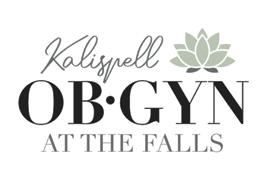

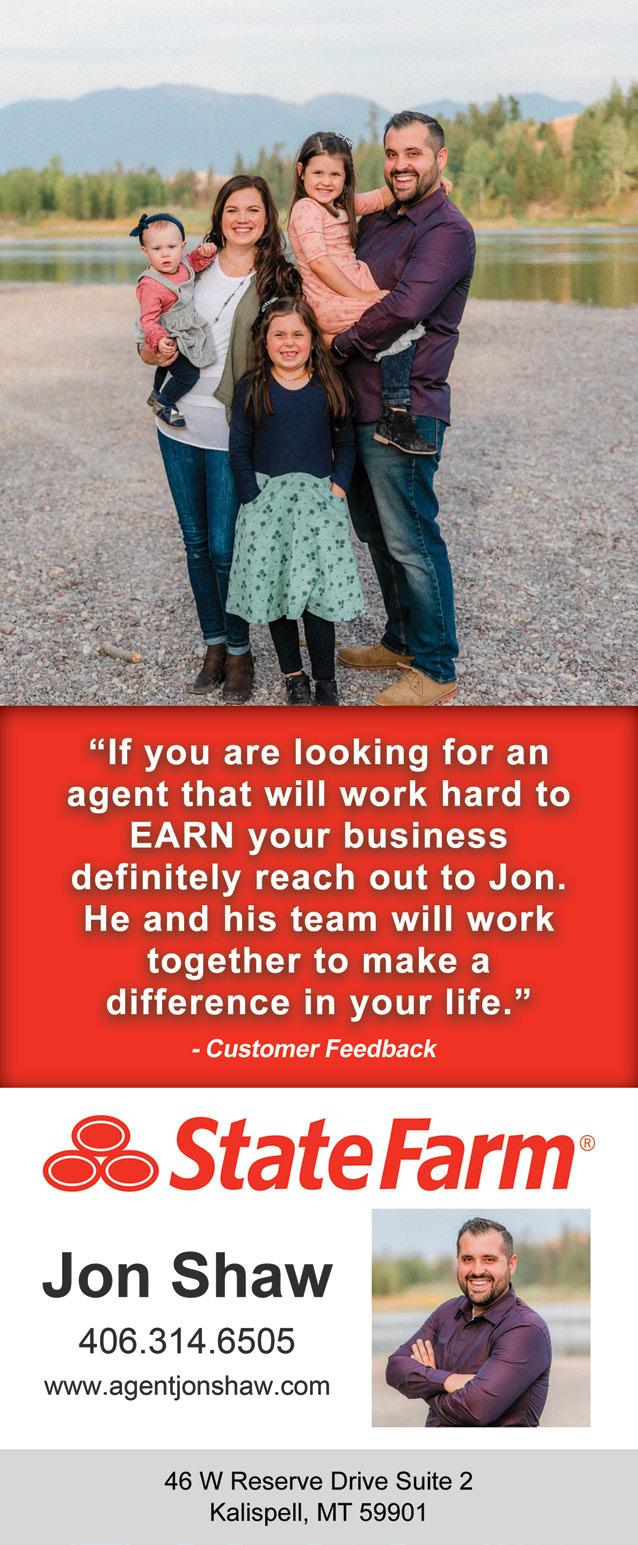


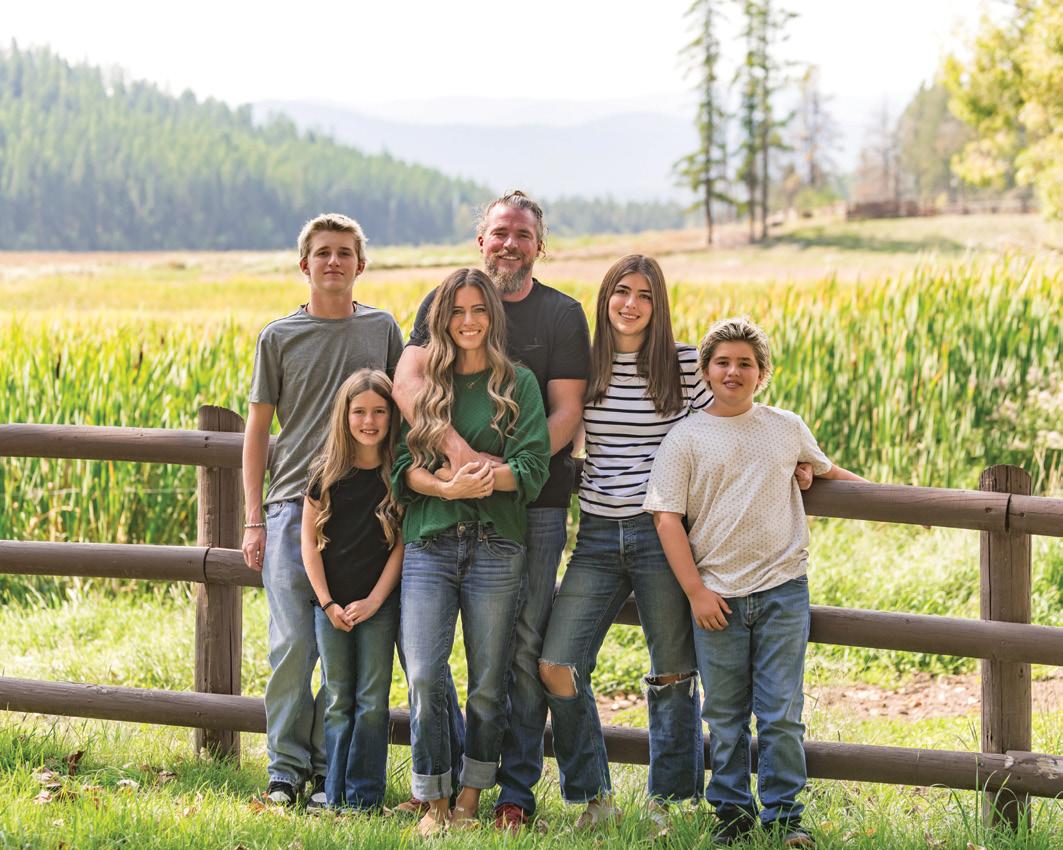
Twenty years ago, Juli Zobell changed her last name to Miller as she became my wife. At the time we were both in our early-to-mid-twenties and to put it bluntly, we were Dumb. After all the ceremonies and celebrations, we sat amidst a pile of amazing gifts and envelopes from friends...of our parents. As we sat there and opened these great gifts, we found ourselves saying things like, “these guys have money, why couldn't they have just given us a ‘Benjamin’ or something?” That is the mindset and language pattern of young, immature, less intelligent, and ungrateful kids.
One gift in particular will forever stand out. It was a book: The Four Laws of Debt Free Prosperity: The Chequemate Story. It was paperback and not very thick. “What are we going to do with this little book?” we thought. “Quick, open the front cover; Maybe there’s a ‘Benjamin’ inside.” Ultimately, the little book was packed away with the other gifts as we prepared for our move to Mesa, AZ.
Boredom. That is what drove my new bride to pick up the little dusty book and turn the first page. Why was she bored? Don’t hold this against her, but my wife is, believe it or not...Canadian. Being such, it took her some time for all the Permanent Resident paperwork and red tape (in this context, let’s call it Red White & Blue tape) to be completed and approved. In other
By Dr. John F. Miller DDS - SMILE MONTANA
I want you all to consider the 1 in 60 rule. Simply put, the rule is that for every 1° you are off course, you will end up being 1 mile off course after traveling 60 miles. Consequently, getting just 1° off course at the start will result in you becoming farther off course the longer you travel. We can deduce that this rule goes both ways. Small destructive changes get you farther from where you want to be, while small positive changes will result in you getting closer to where you want to be. For the context of this article, we will substitute distance for time.
words she could not work for a few months so there she was; In a strange place, with no money, no friends, and no husband for a better part of her day.
And then one day it happened. I walk through the door to a forever changed woman who has been glued to this little book like it was written by Nicholas Sparks entitled 50 Shades of Sparkly Vampires. “John, you have to read this book. It is amazing,” my wife insists. This being a dental column which should mention teeth and mouths at some point, I’ll make it short. We became students of this book and it has influenced every day and decision of our lives from that boring Arizona day 20 years ago. After a couple hundred pages we were a little less Dumb (positive 1° shift) and we now refer to it as our “million-dollar” wedding gift. Our path in life was irreversibly changed for the better.

I cross paths frequently with the man who gave us that book and I always thank him and tell him how much that gift influenced our young and impressionable financial attitudes. During these chats, this gentleman always expresses the following: “You two are so lucky to learn these habits while you are young.” And there you have it folks, The Segue. Establishing good habits early will produce tremendous
returns in all aspects of life. Just off the top of my head I can think of the following examples: Effective Study Habits, Strong Work Ethic, Smart Nutritional Choices, Sound Financial Decisions, Efficient Time Management, Physical Health Maintenance, Strengthening Healthy Relationships, etc.
Just like the 1 in 60 rule, if we make a tiny positive change but only persist for a short period of time we will not realize the positive results of this change. It requires time. There are no real shortcuts in life, no ethical get rich quick schemes, no healthy get skinny by the weekend techniques.
Nowhere is this more obvious to me than the Oral Health habits of the Flathead Community that I serve. The two major oral diseases that we will all combat in life are Cavities (caries) and Gum Disease (Periodontitis). These diseases have some unfortunate characteristics: 1) They both are painless until the later stages of the disease. 2) They both progress very slowly in most cases. I always hear, “Hey Doc, you must get busy after Easter with all the candy that kids are eating.” I respond, “Easter is going to keep me busy 2 years from now.” 3) The majority of cases are invisible to their victims. You would not be able to recognize the problem by looking in the mirror until the latter stages of the disease. 4) They very rarely affect localized areas of your mouth. In other words, if there is tooth decay or bone loss in one area of your mouth, chances are it is present in the rest of your mouth as
There are no real shortcuts in life, no ethical get rich quick schemes, no healthy get skinny by the weekend techniques.
well. Dental professionals would classify this as a “generalized” condition. A “localized” condition would be the exception rather than the rule.
These four characteristics create the perfect storm for major problems. Let me present a scenario that we see all too often. Mikey is a 25-year-old recent college grad who has been at his new job for the requisite 6-months to qualify for the companies Dental Insurance. He exclaims that it has been approximately 8 years since his last cleaning and check-up but his teeth feel fine. He has noticed some occasional mild sensitivity while eating sweets and his breath “could smell better” Mikey admits. “Just need a cleaning Doc, I have a blind date this Friday.”
After a thorough evaluation of Mikey’s X-Rays and teeth, decay is found between 12 of his teeth in addition to calcified plaque (calculus) deposits beneath his gums that have resulted in Generalized Mild Gum Disease requiring a more advanced multi-visit cleaning. Mikey is shocked. After insurance he will still owe thousands of dollars to restore his teeth back to health. I inform Mikey that his oral condition will never be easier or cost less to fix than it is at this appointment.
He would never admit this but I will tell you, Mikey brushes maybe once a day for 25 seconds and can’t remember the last time he flossed. Mikey did not develop good oral health habits in his youth. The problem was his poor habits, in other words his 1° shift, not necessarily the 8 years away from dental care.
Let’s introduce you to a new character: Good Habits Ricky. To keep things short let’s just say Ricky brushes twice a day long enough to get all the areas of his teeth clean, and to keep things realistic let’s say he flosses 4 times a week the right way. When plugged into Mikey’s scenario Good Habits Ricky comes away with needing fillings between two adjacent teeth and just a standard cleaning to address some localized posterior gingivitis. All said and done, Ricky gets taken care of to the tune of a couple hundred bucks after insurance. To develop Ricky’s character further you should know that he was also shocked by needing the fillings.
The reader is now questioning me saying, “well, why did Good Habits Ricky have 2 cavities? After all, he has good habits.” True, but in the scenario he did not go to the dentist for 8 years. His good habits, while allowing minor damage, prevented more significant damage. It is possible to stay away from the dentist for extended periods of time and remain free from oral disease such as cavities and gum disease, but it requires excellent oral hygiene and nutrition practices. In other words, it is the exception to the rule and is supported by my findings throughout my career.
We were given a little paperback book in our youth. It taught us how to prepare and invest in the future. It prevented the more significant damage that could have occurred had we not developed good financial habits. Invest in your future and the future of your children by stressing the importance of good oral health. There are so many positives to having a healthy mouth and smile. Better overall health, less chronic inflammation, less tooth pain, less money spent at the dentist, better looking smile, more confidence, etc.
In my earlier list of areas of life to develop good habits I left one out, and that is making sure you are having fun. If any of you know me personally you know that having a good time is pretty high on my list of priorities. I know that hounding you on good habits makes me sound really serious, but it's quite the opposite. Toothaches, credit card bills, high blood pressure make life stressful and serious. The good habits I’m encouraging will remove stress from all areas of life and allow you to kick back and enjoy the final weeks of another wonderful Montana summer...while Smiling of course.
